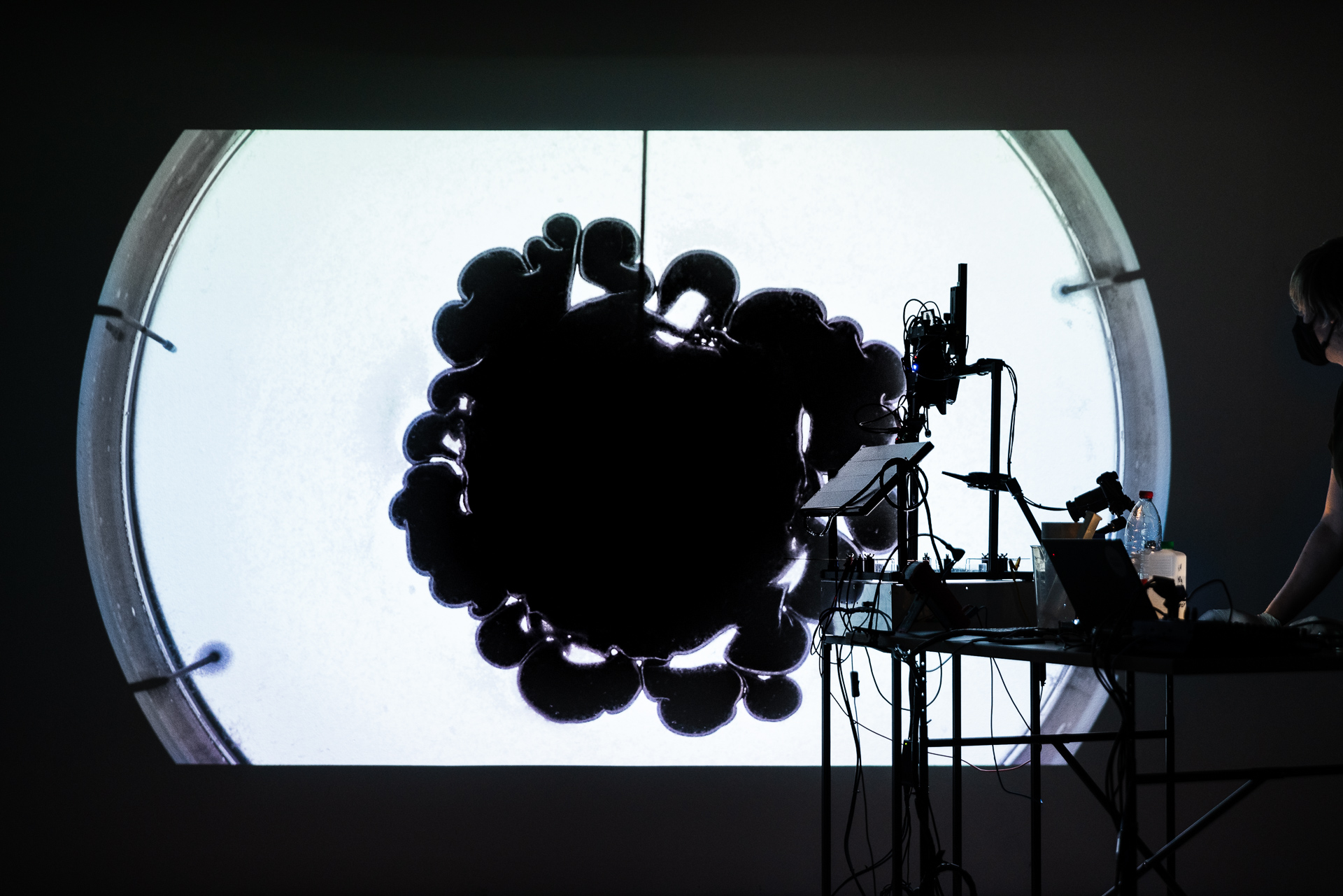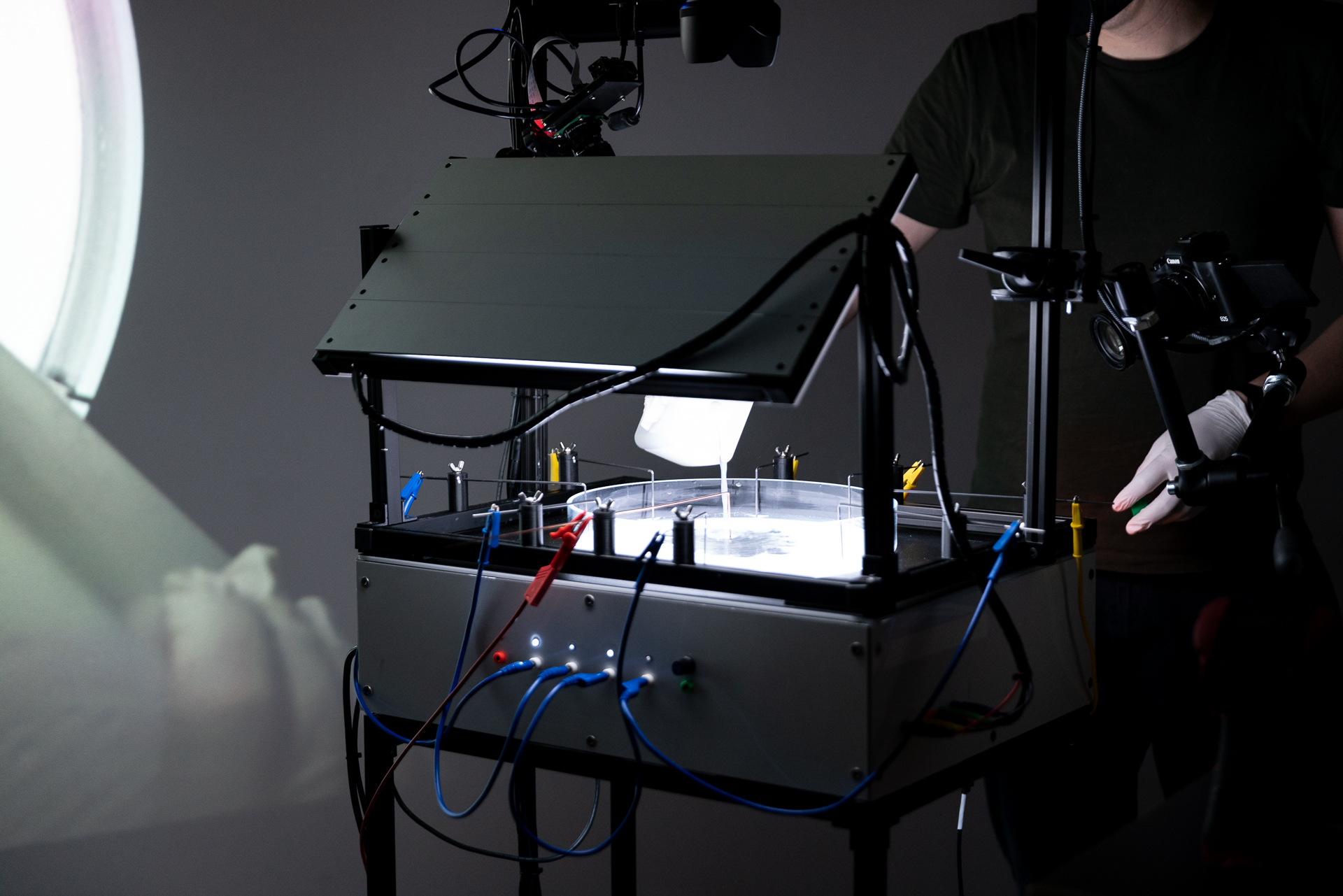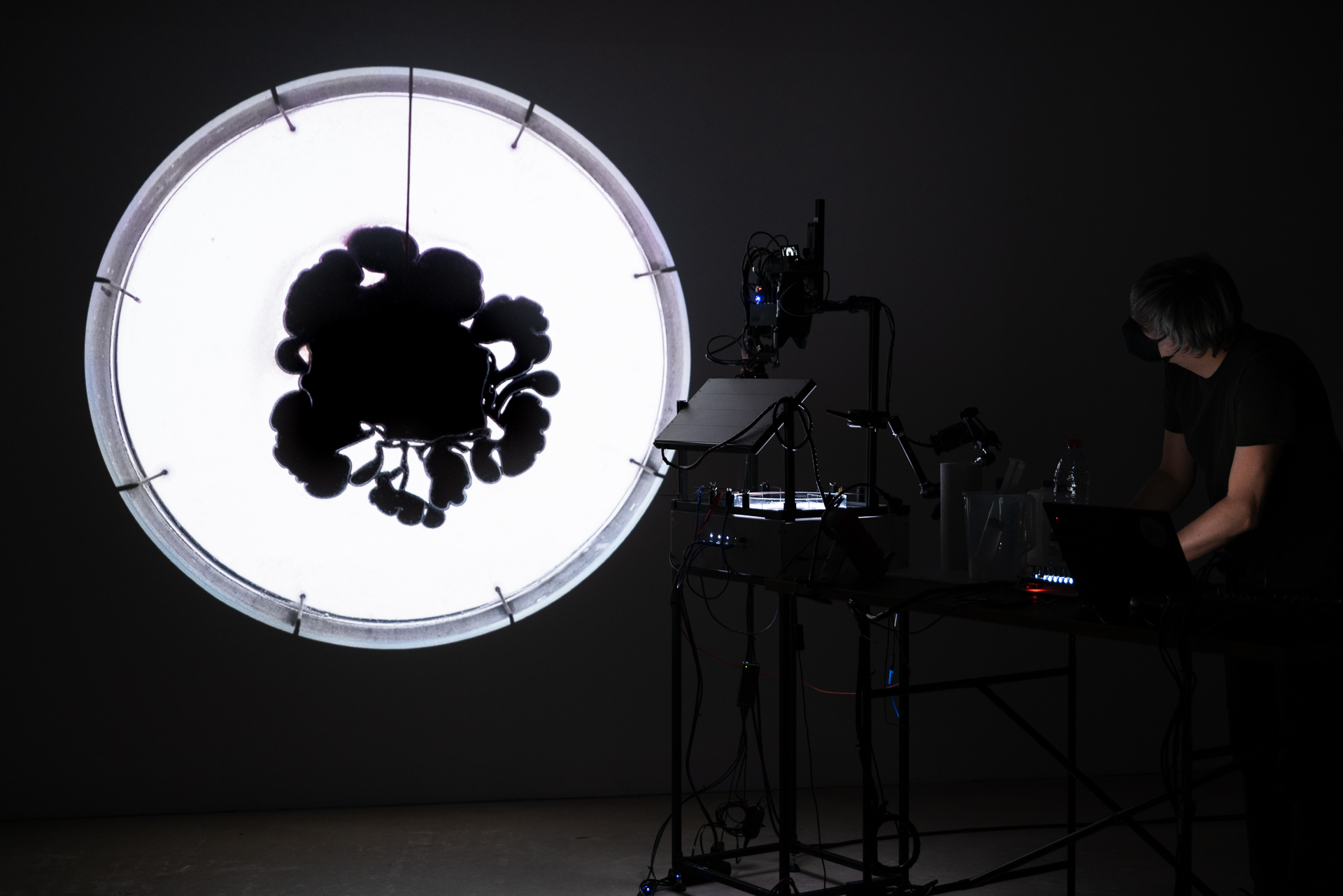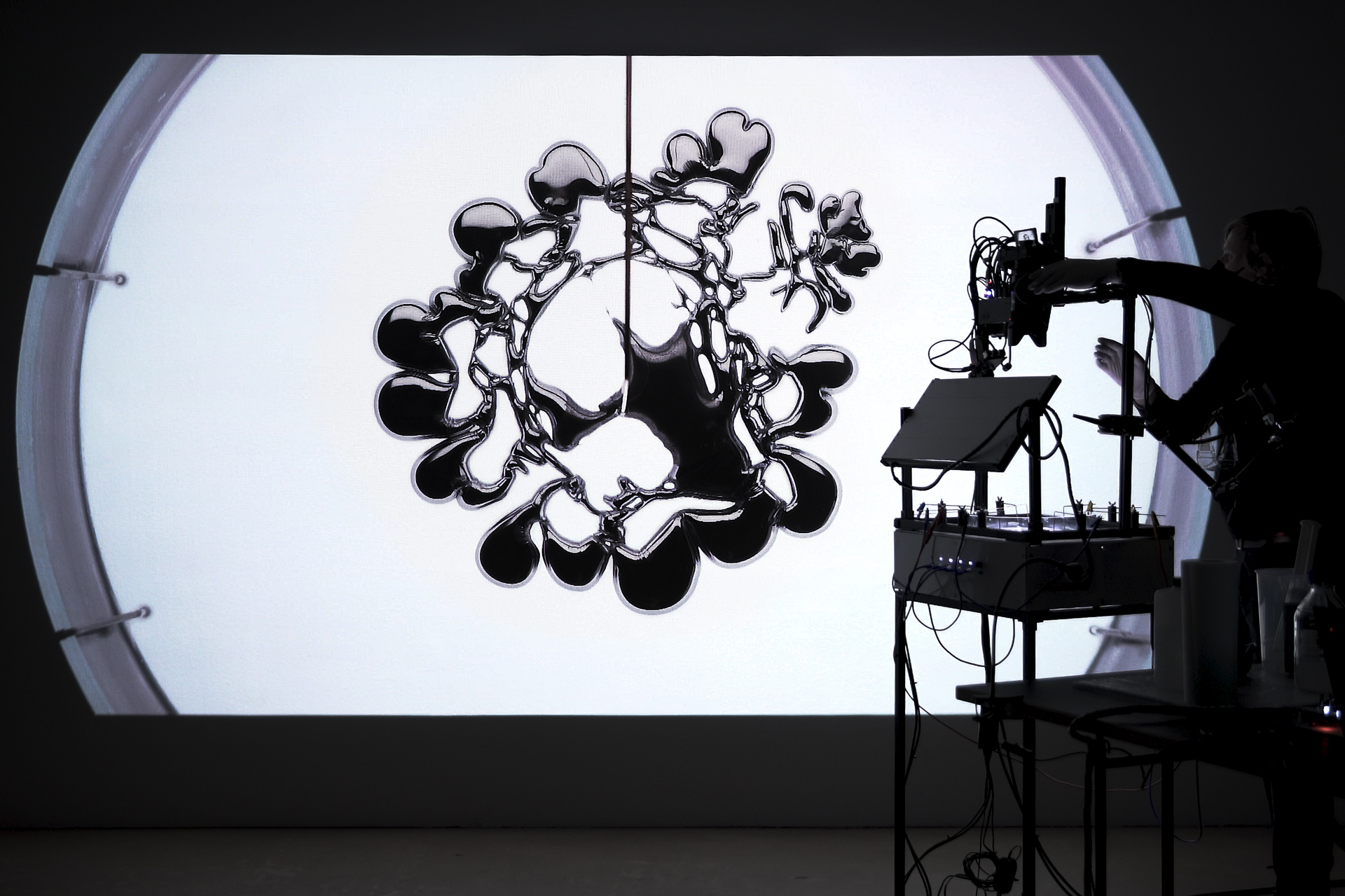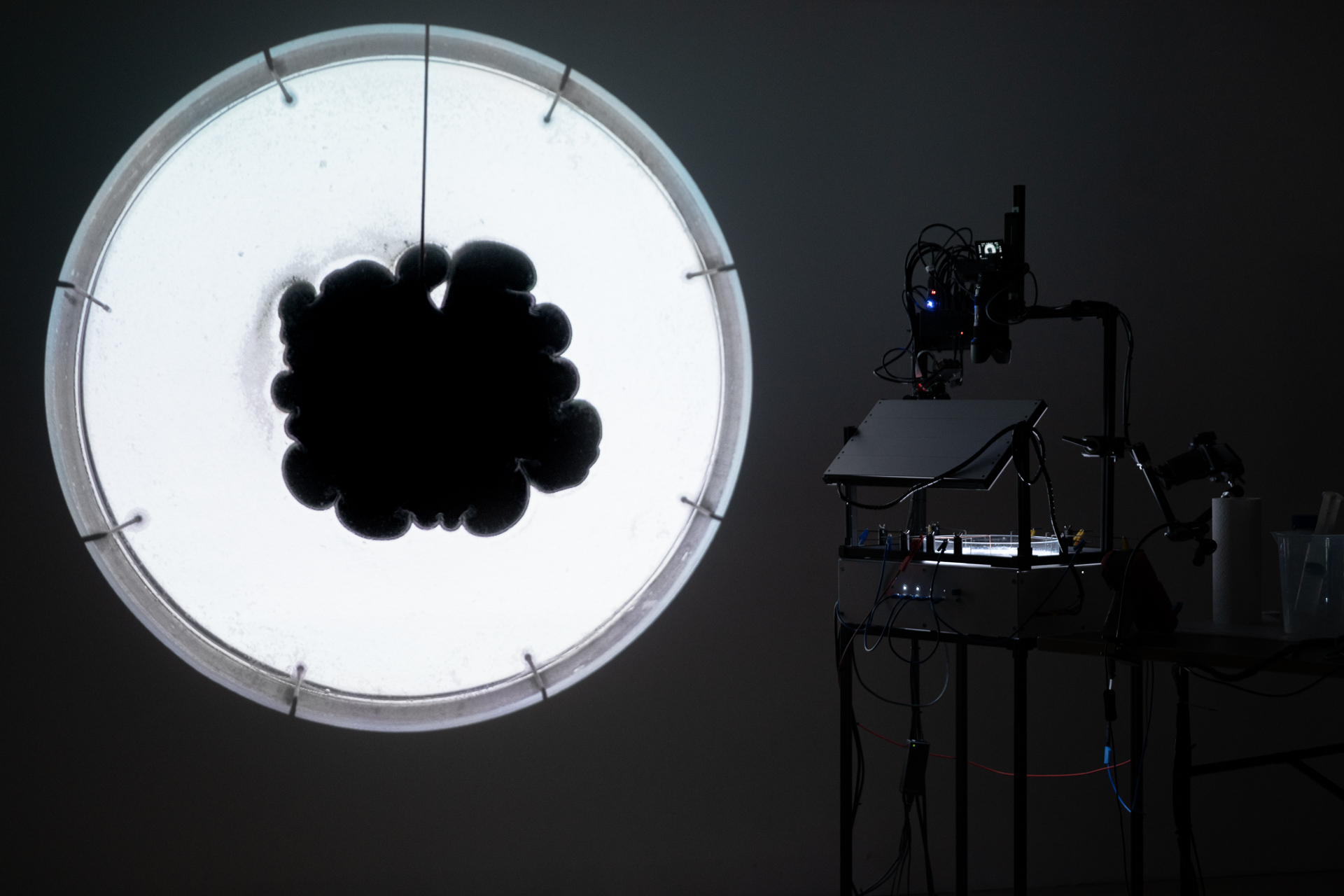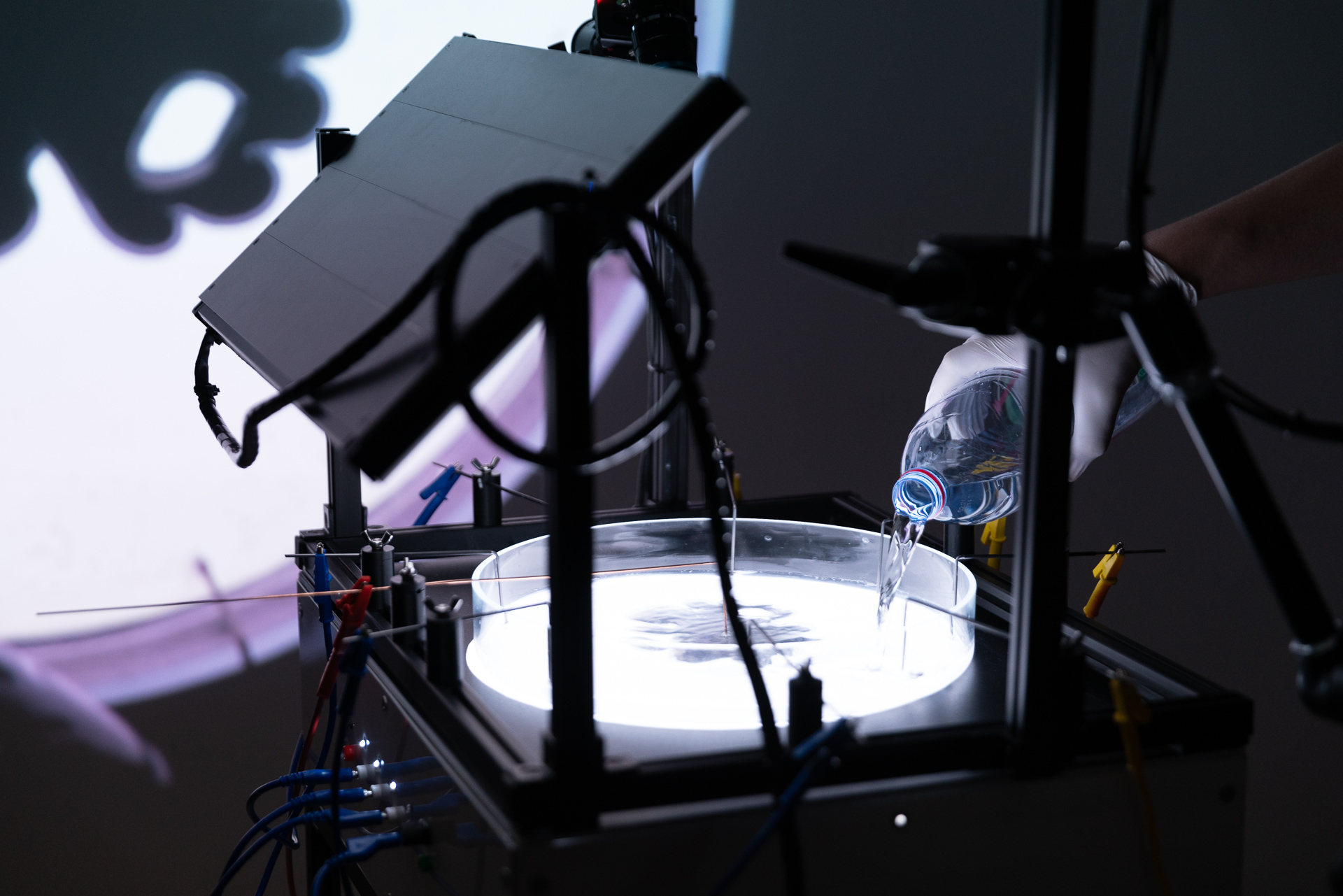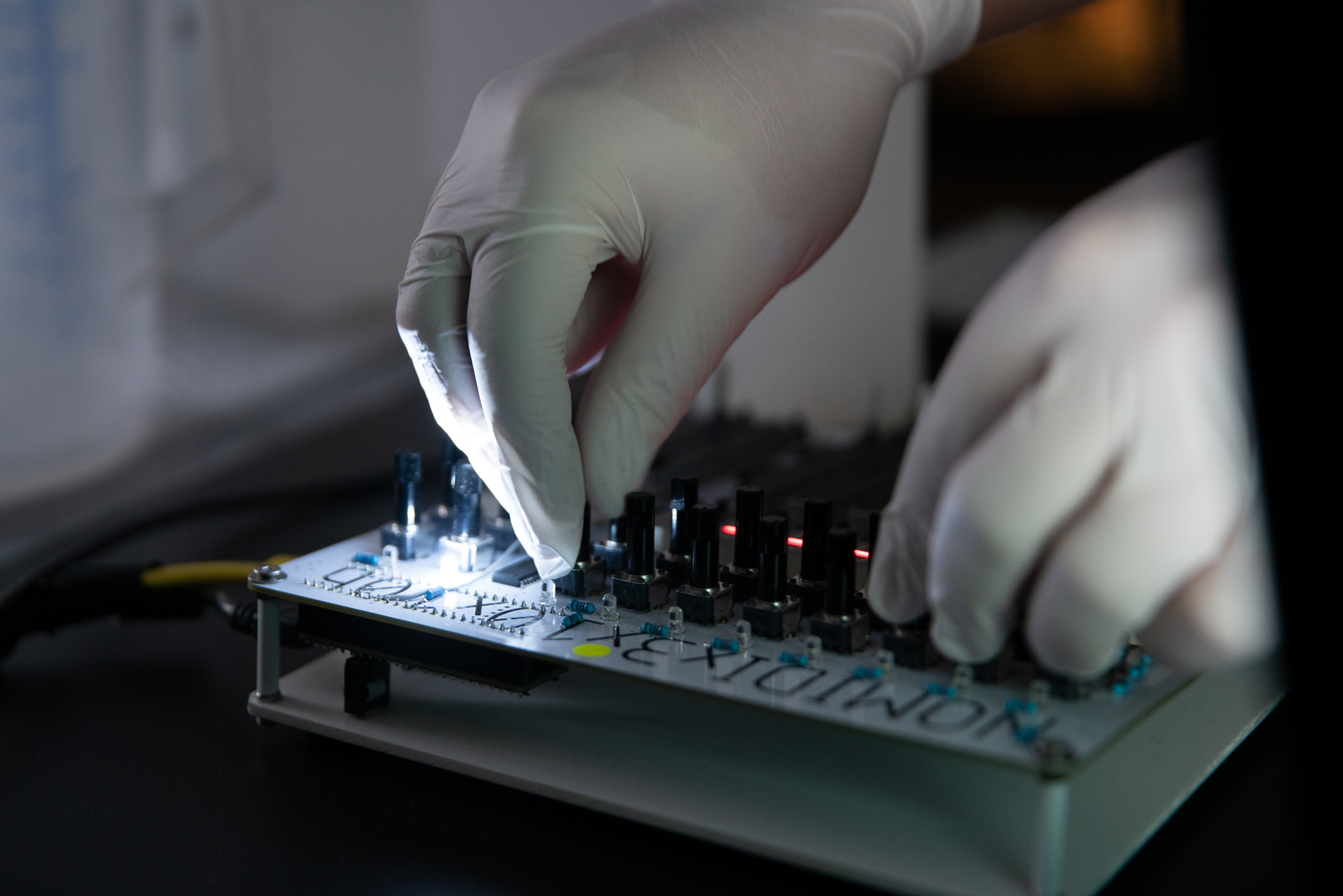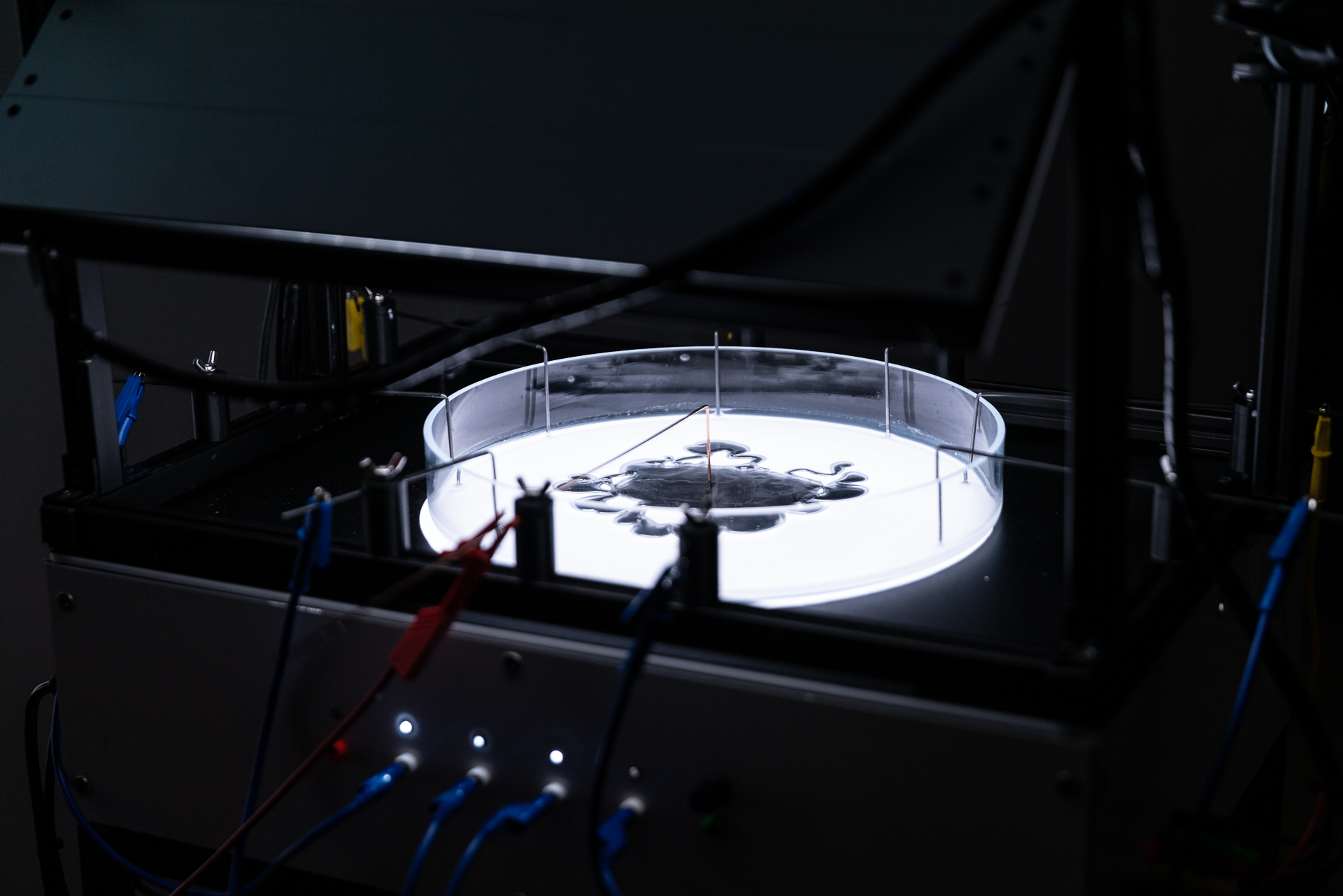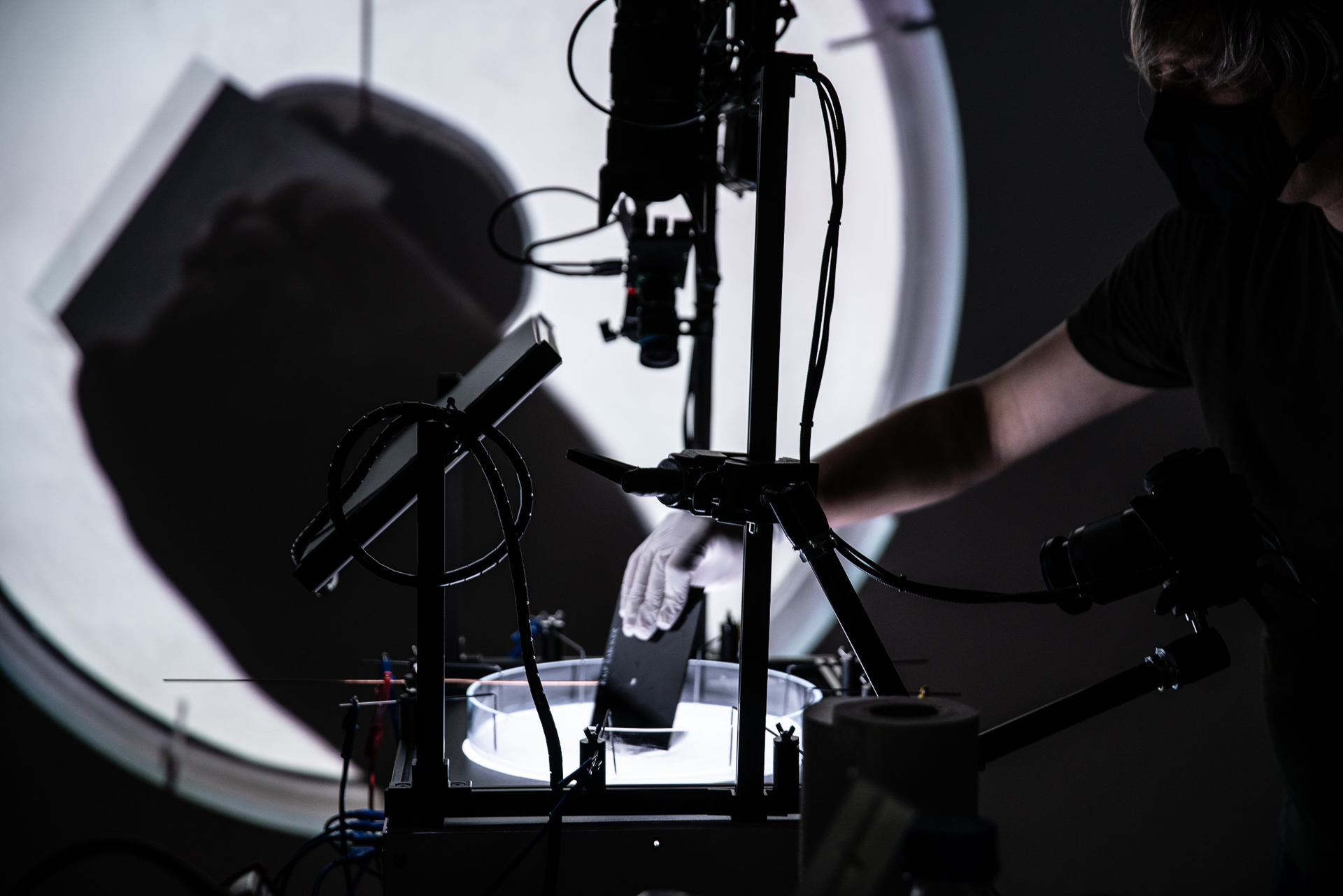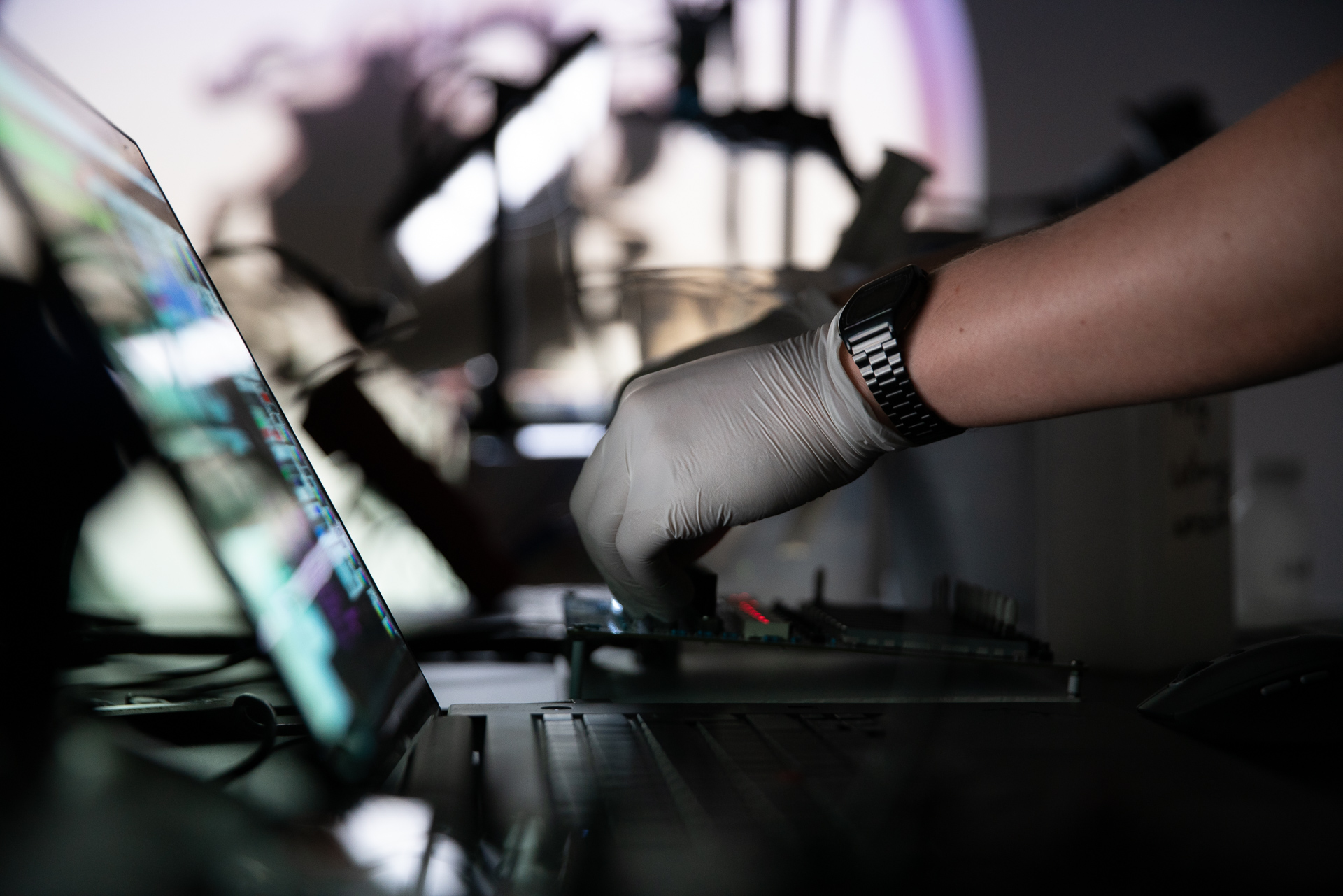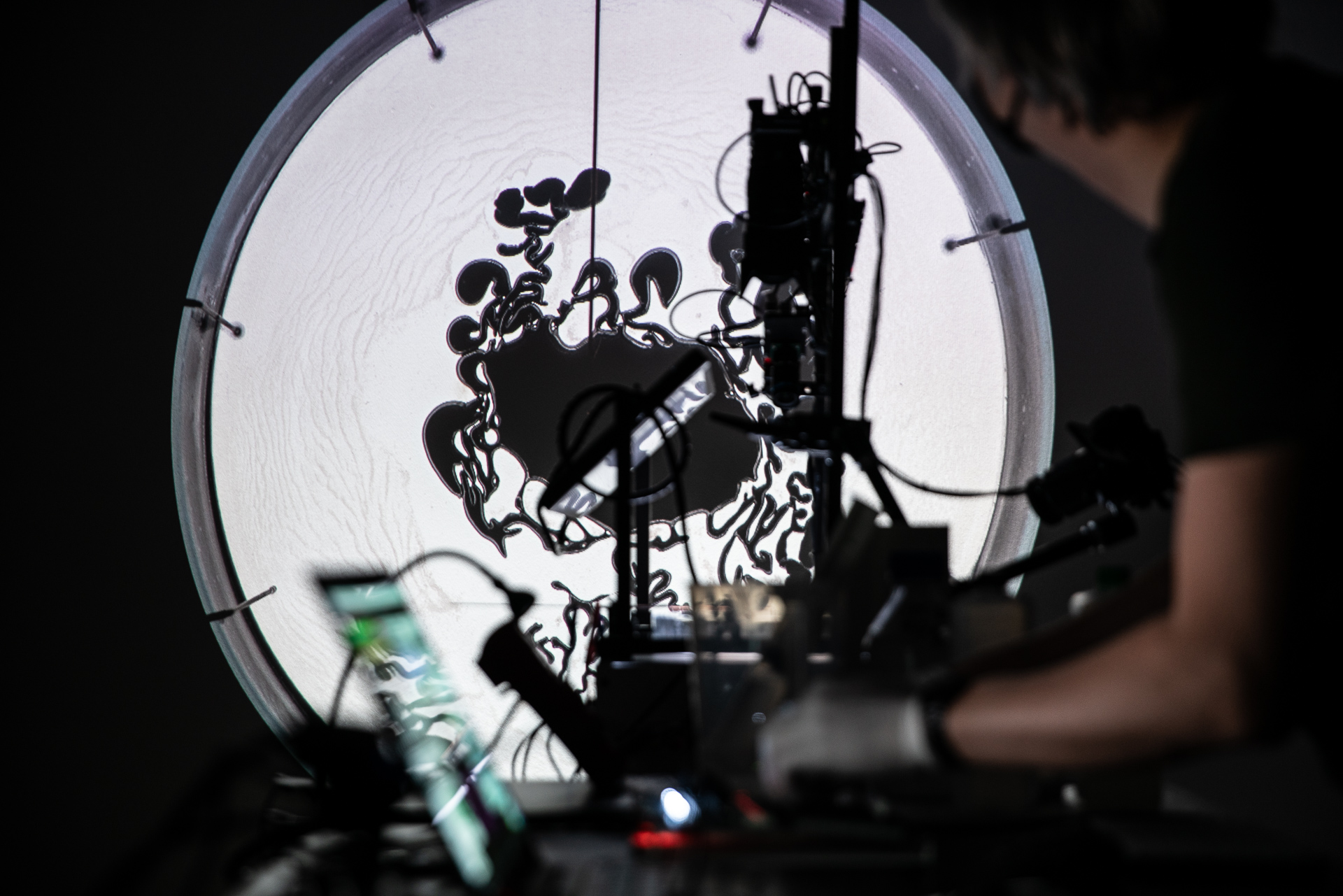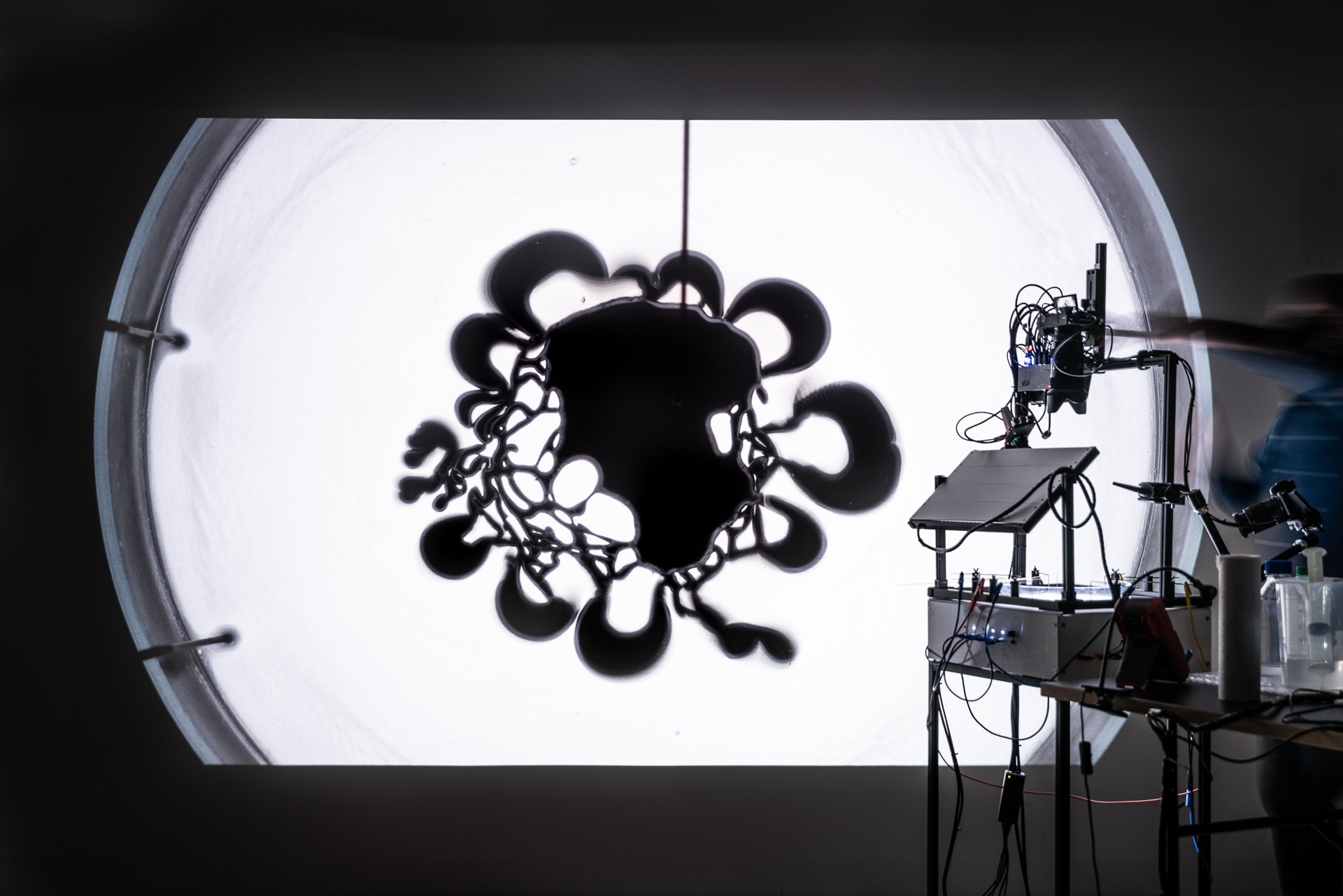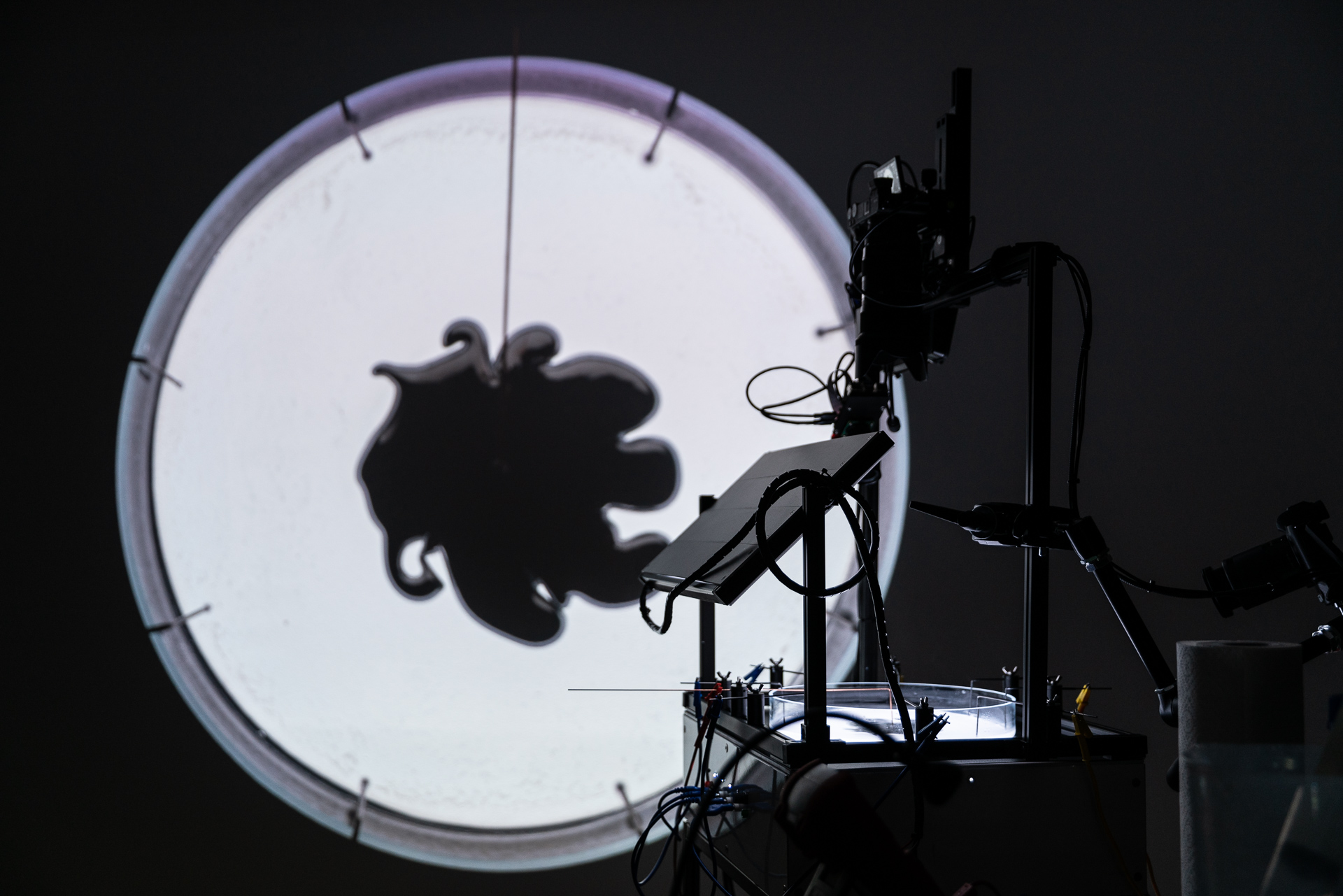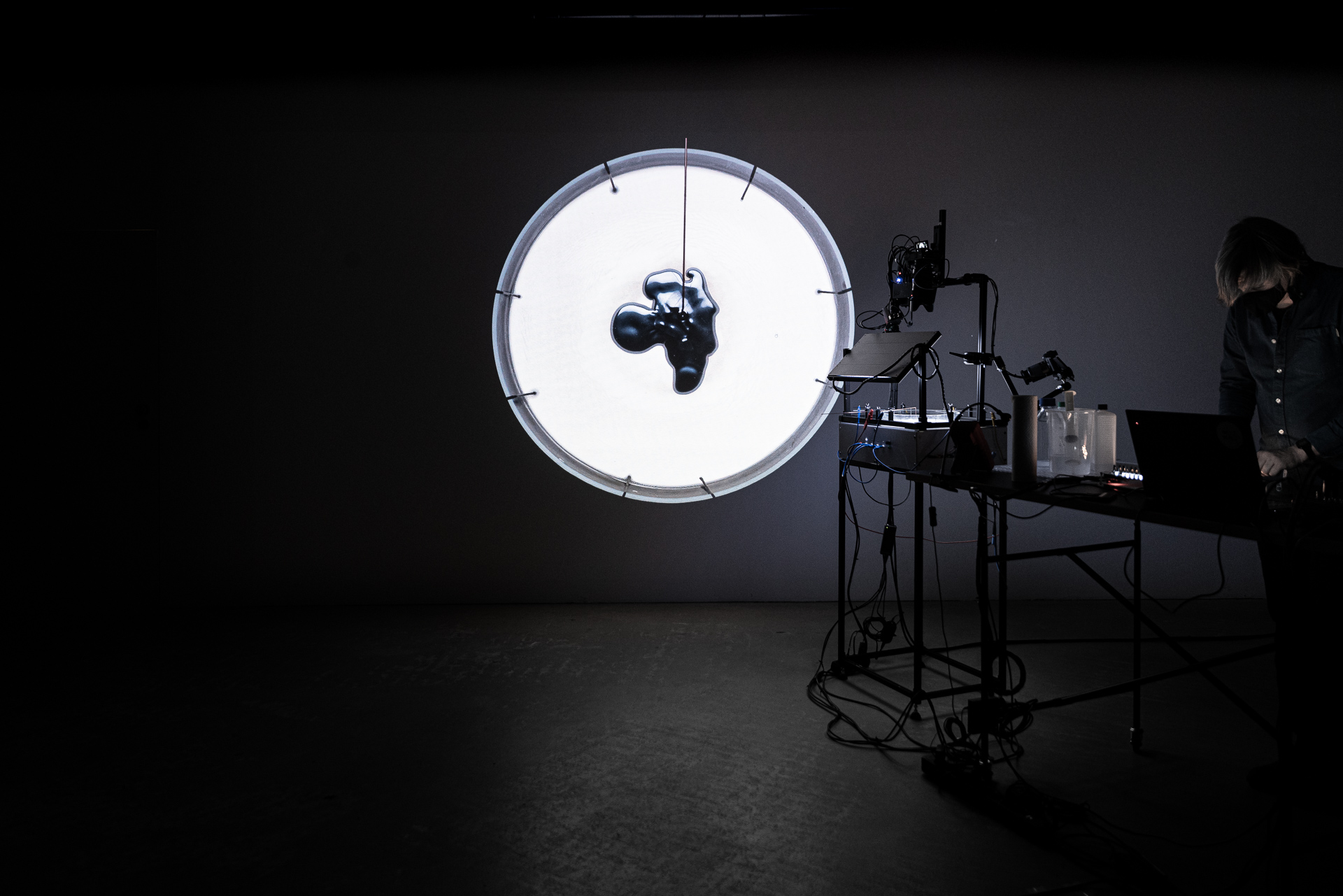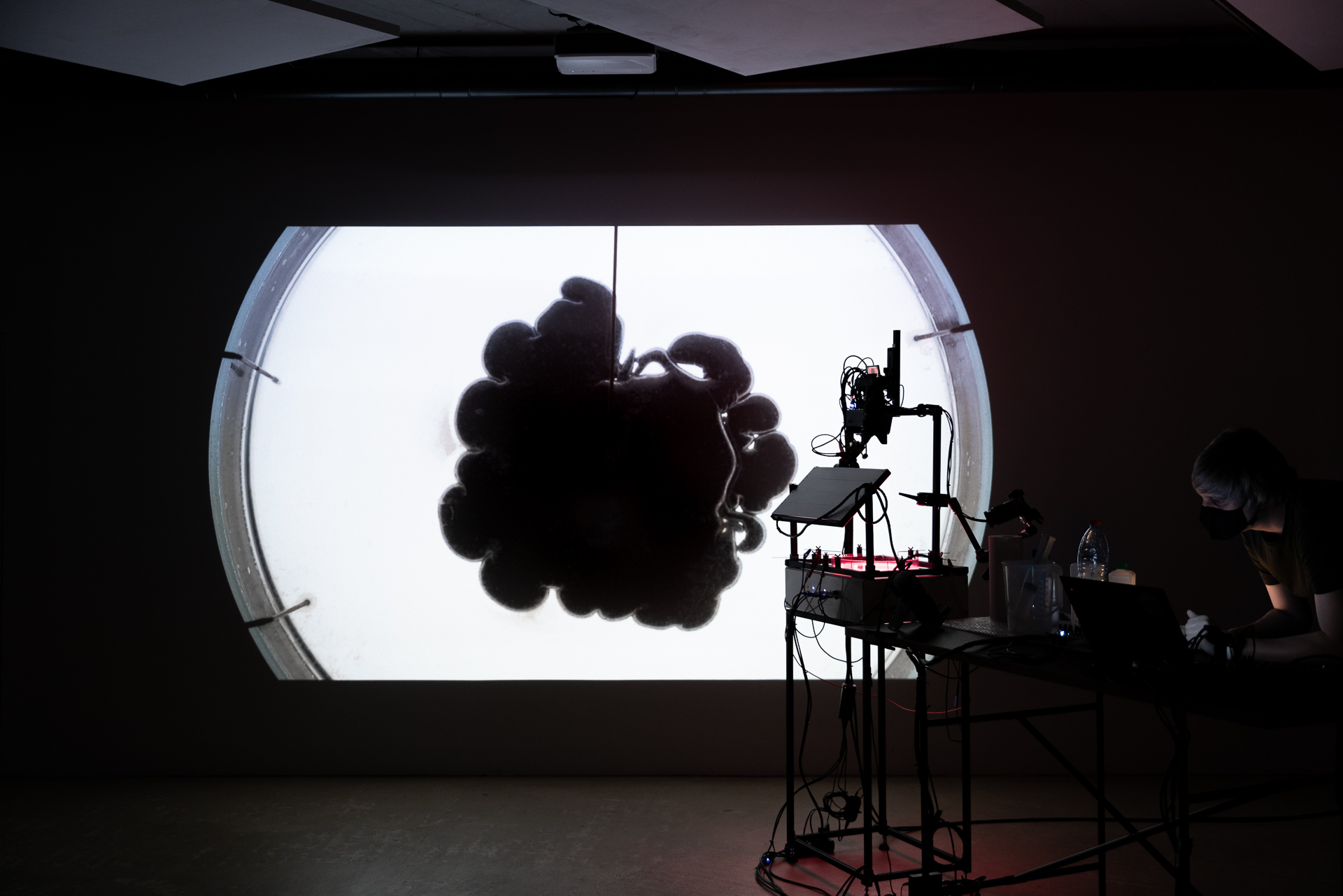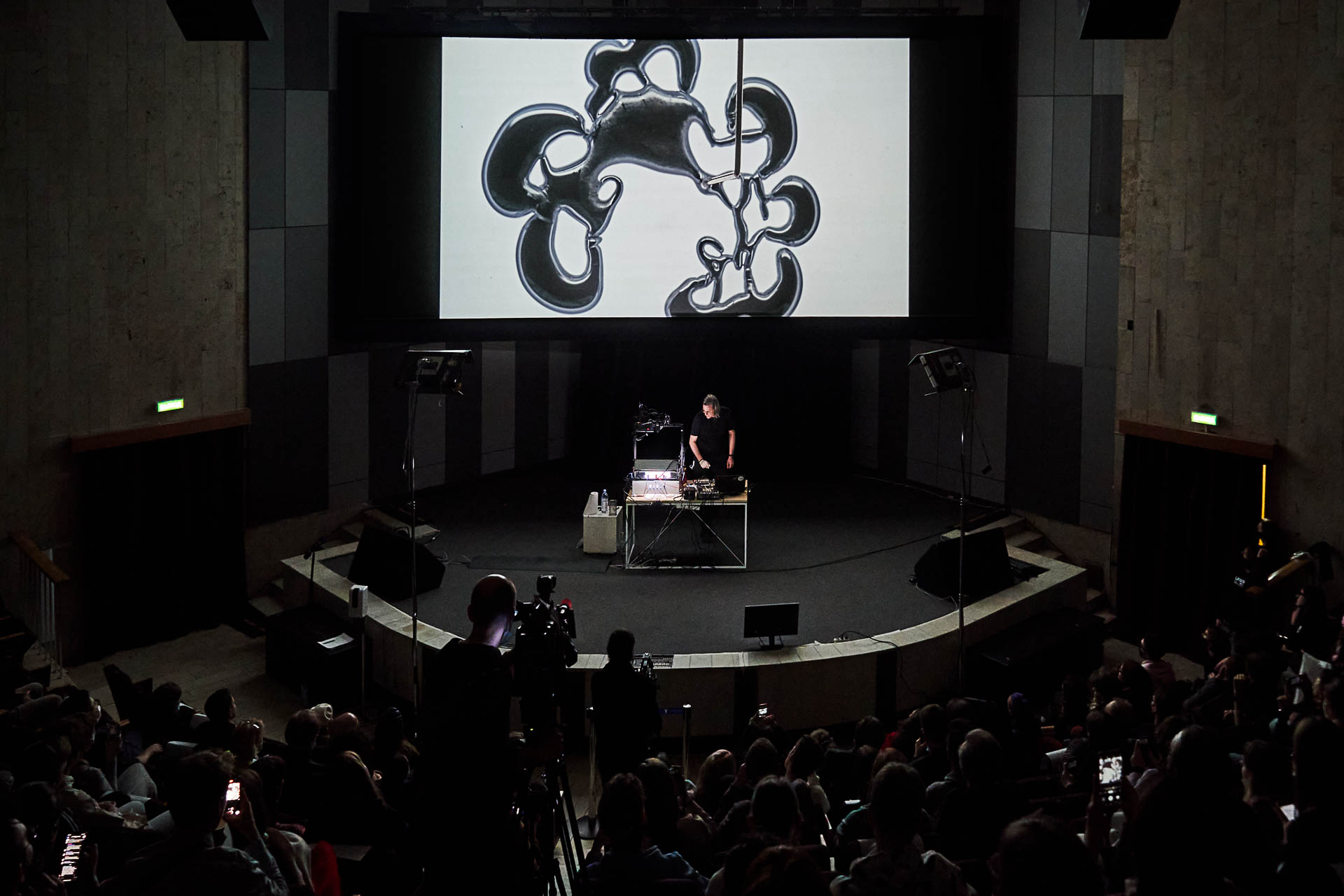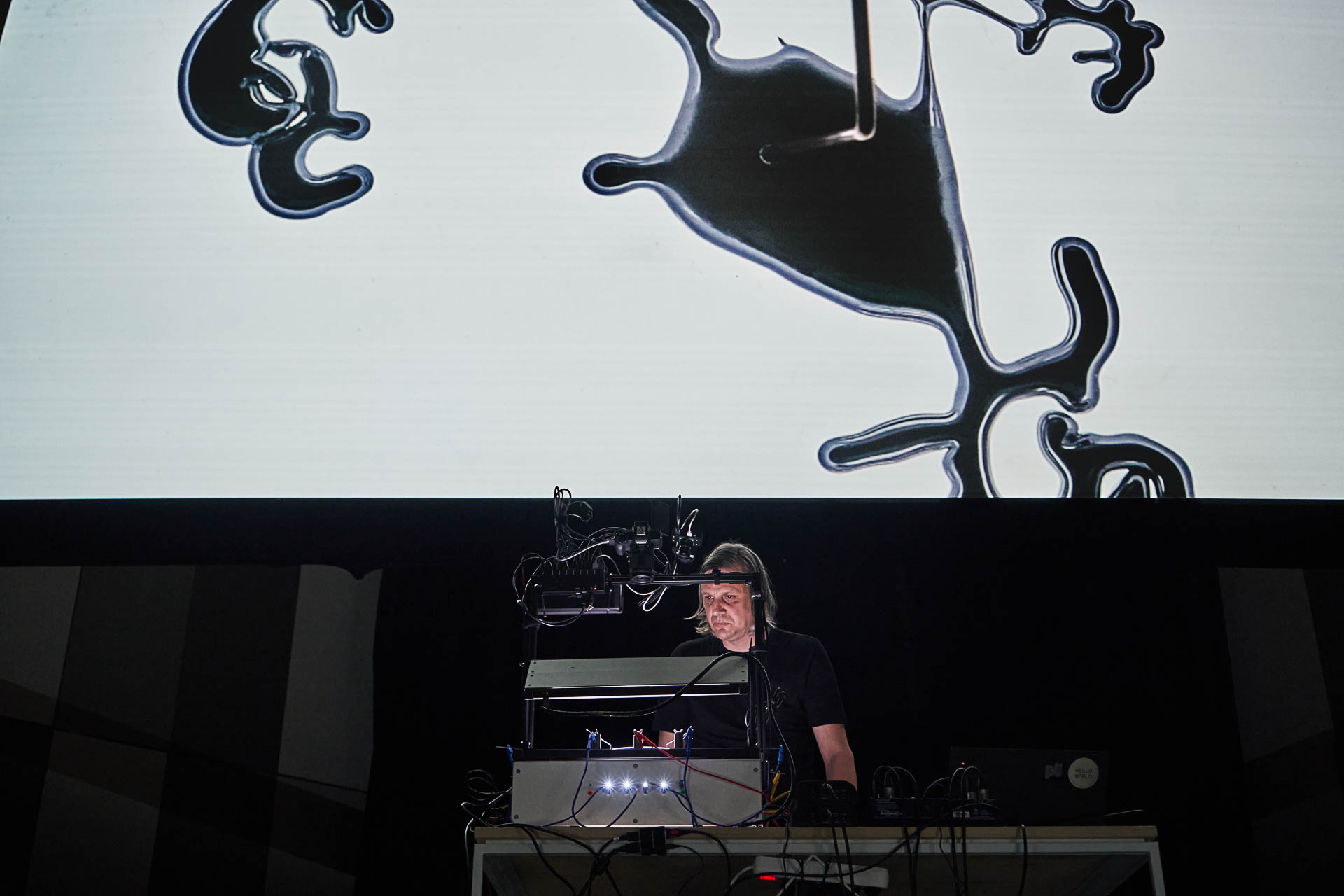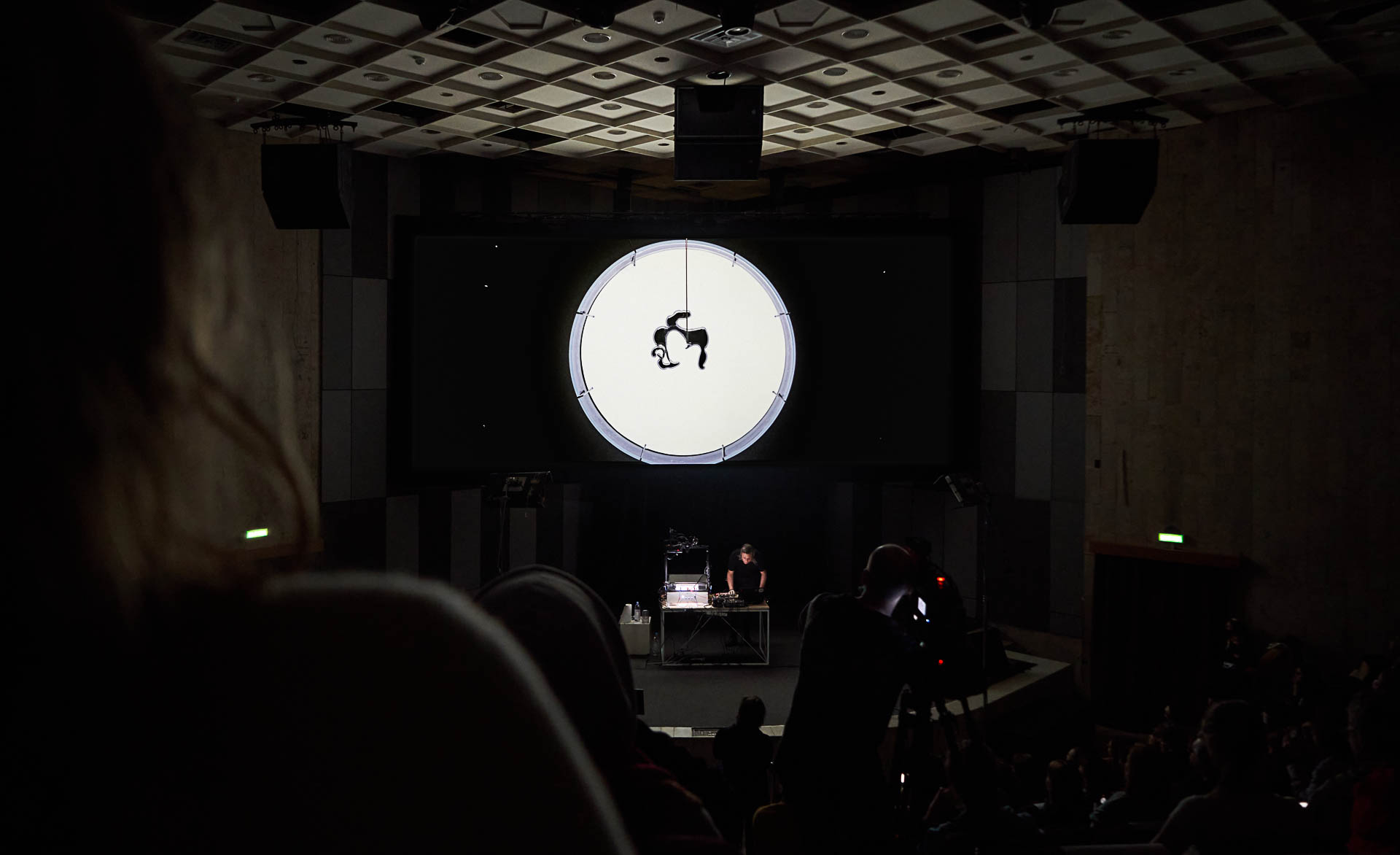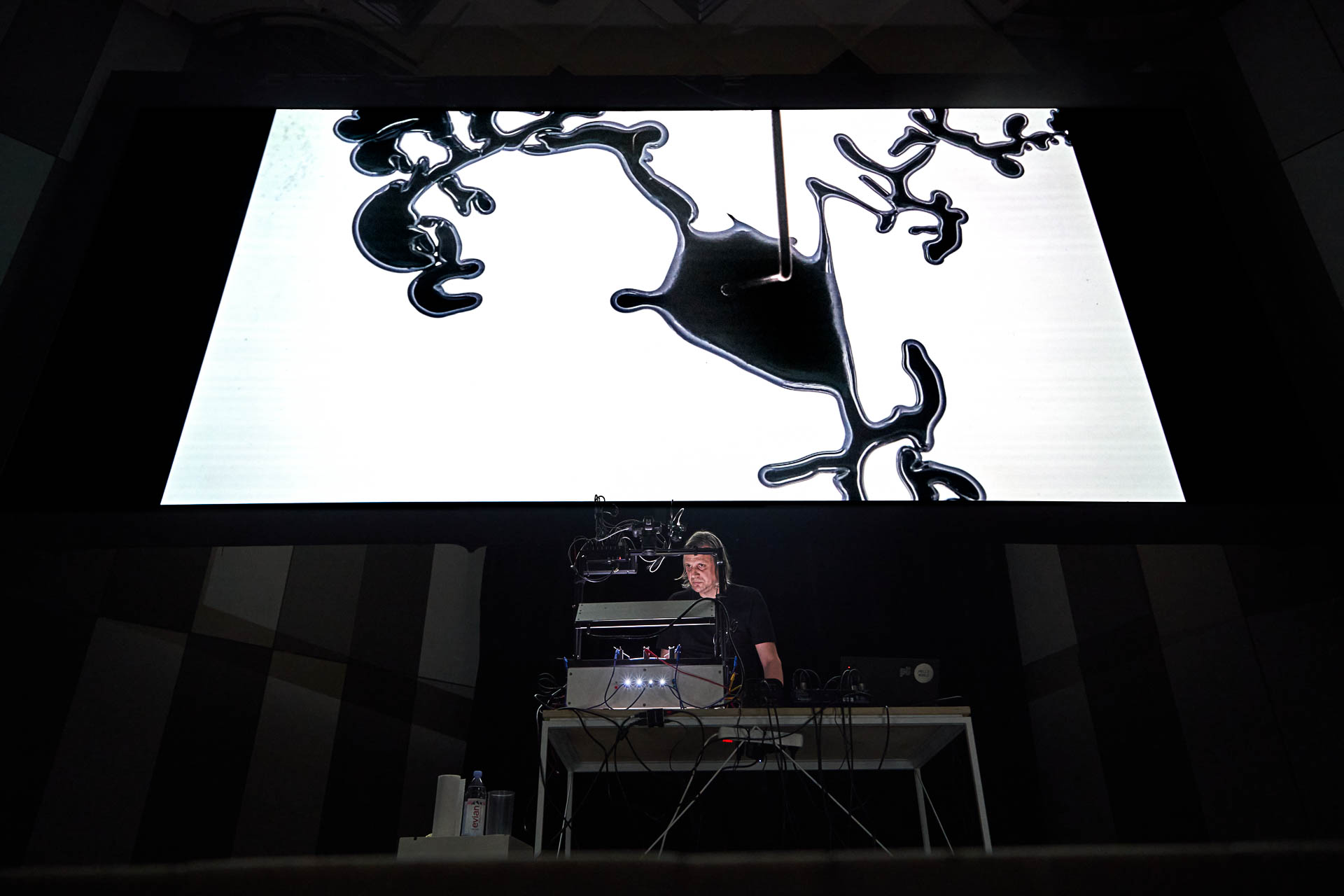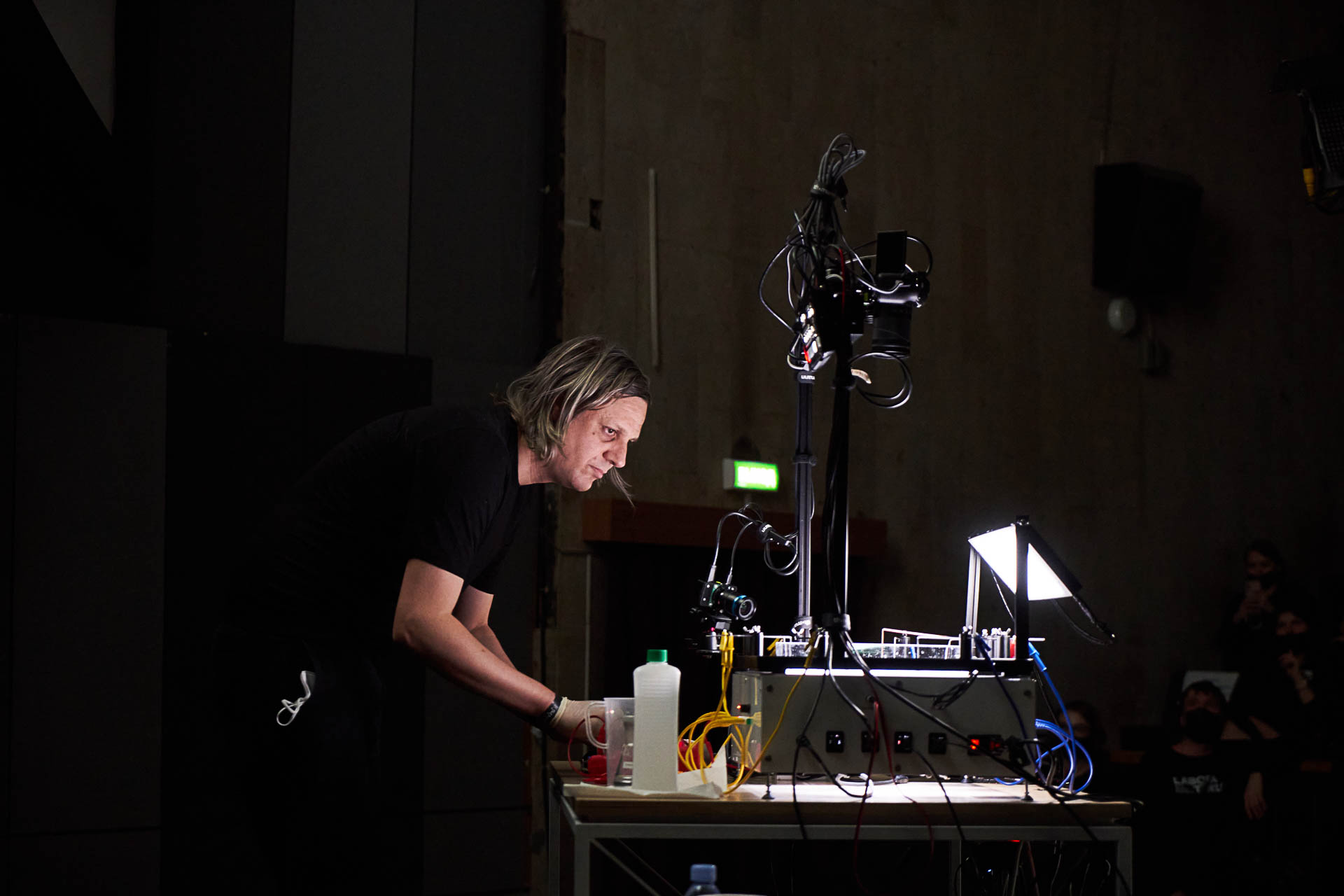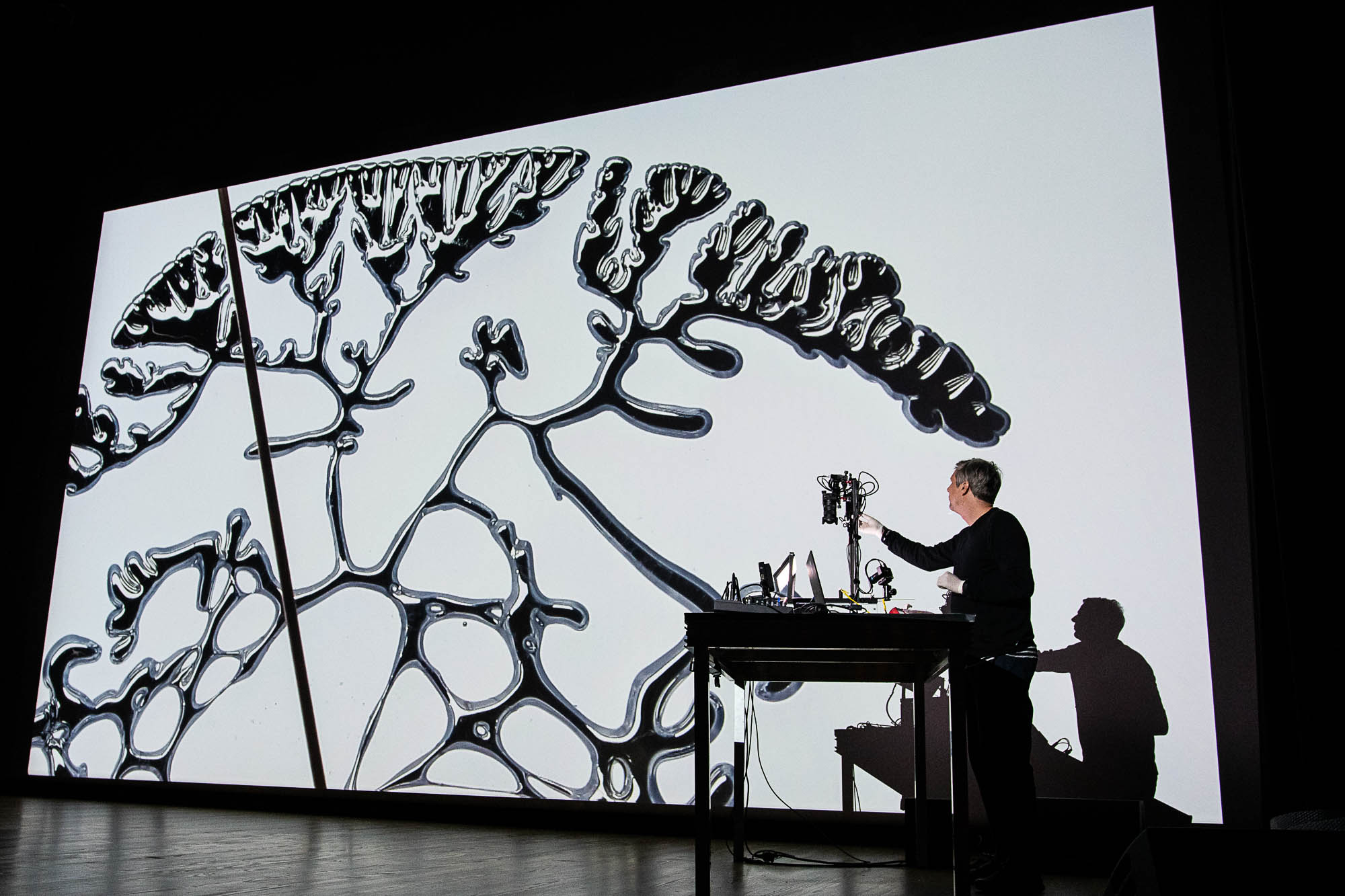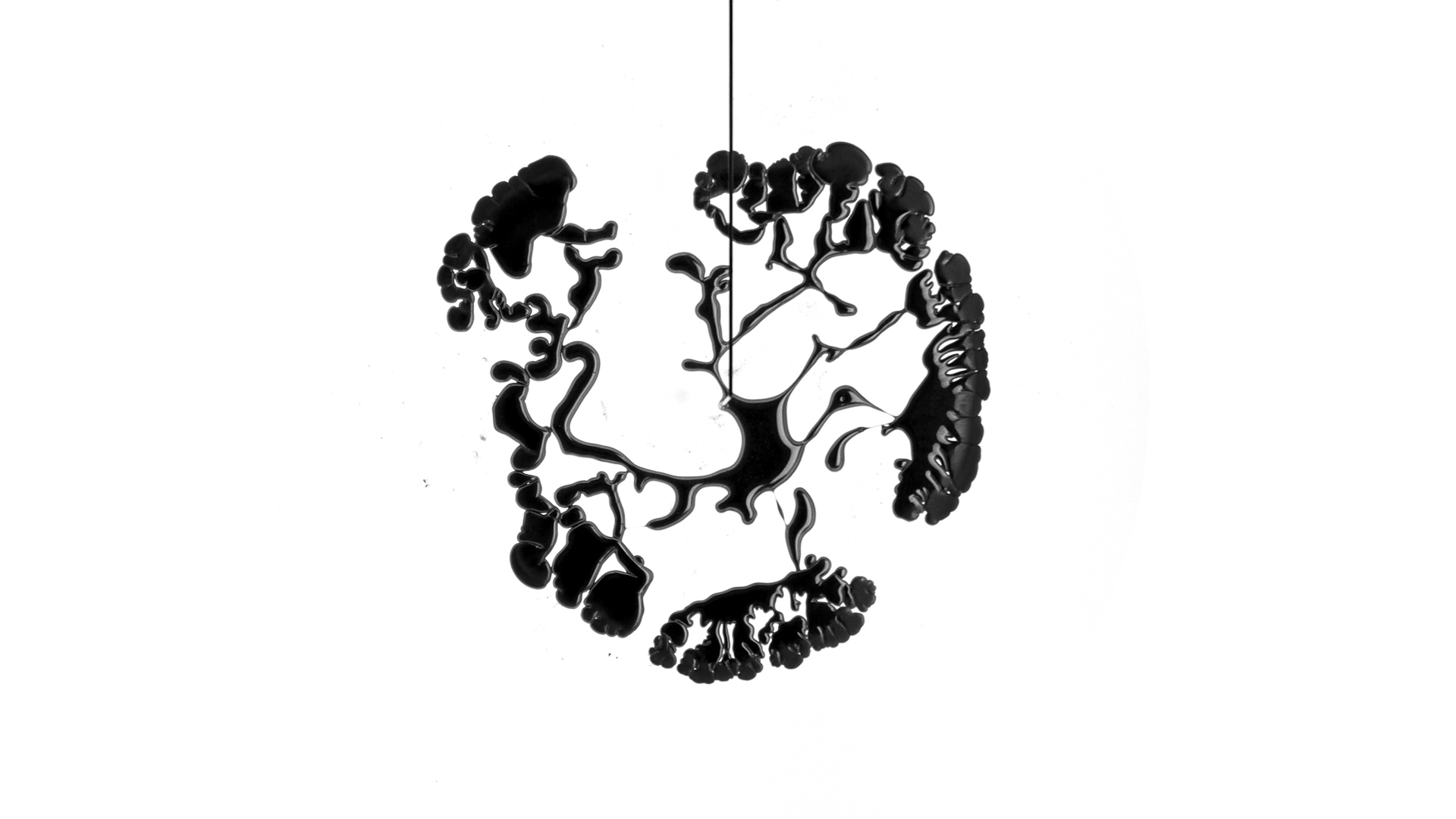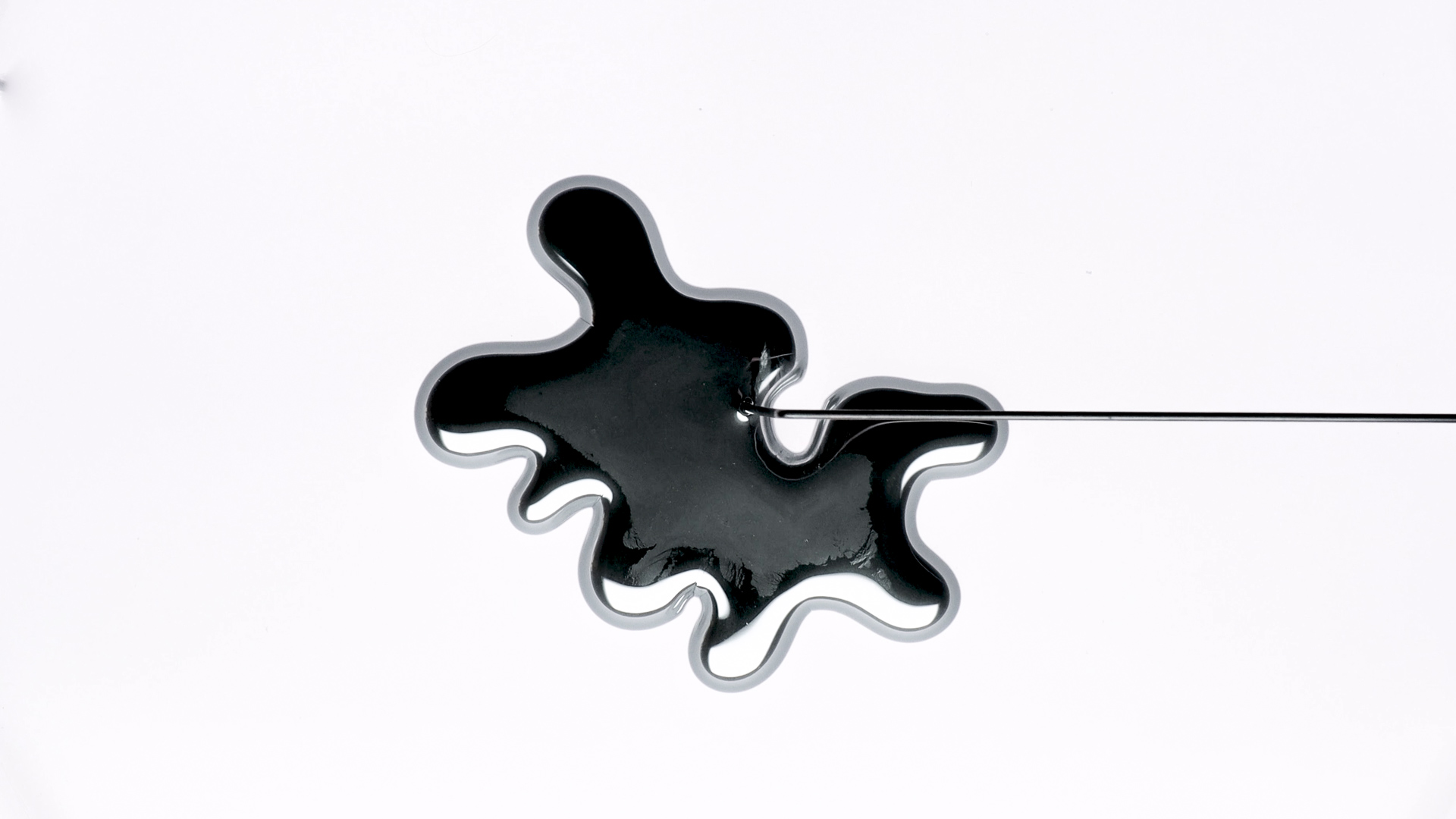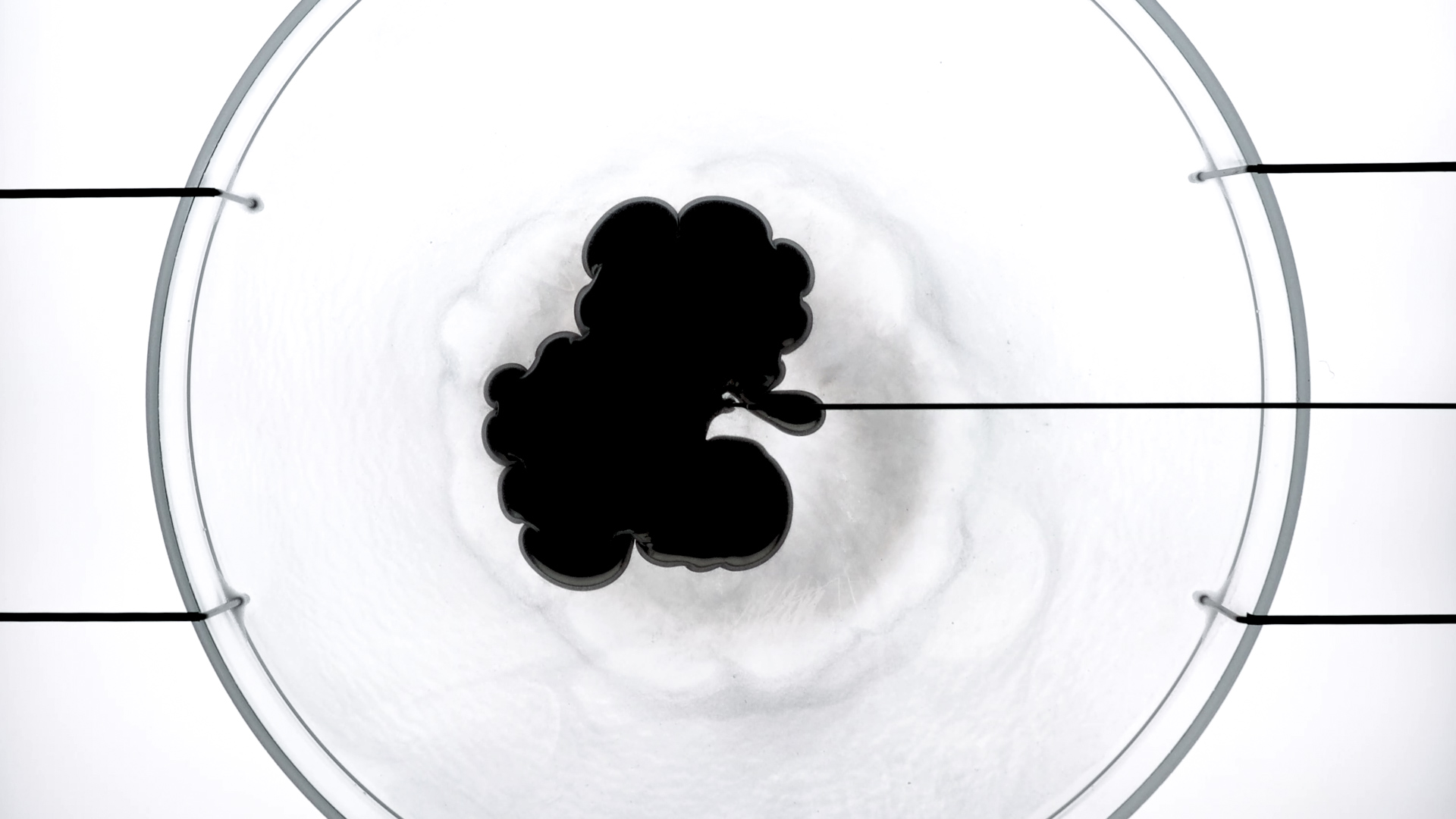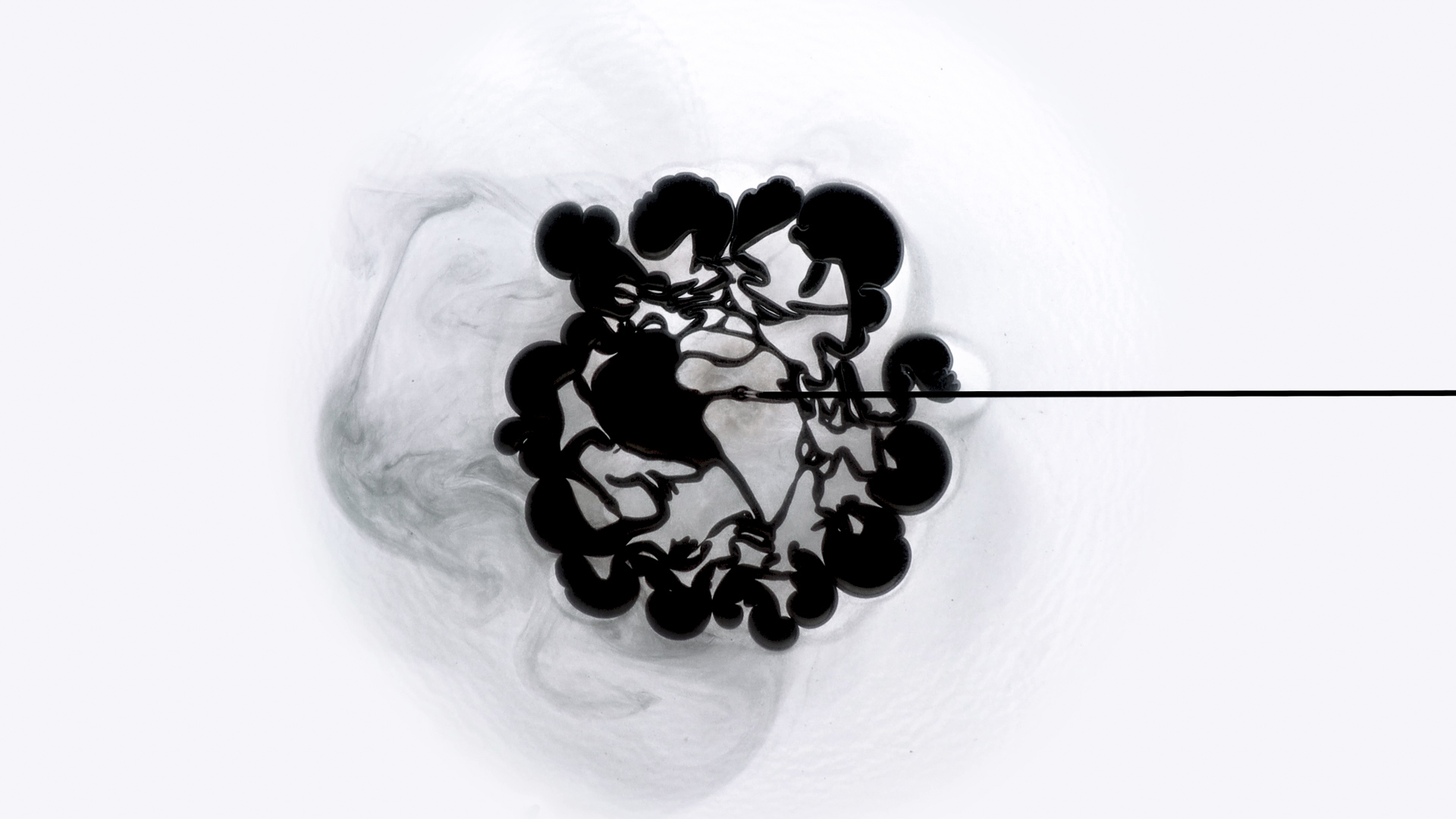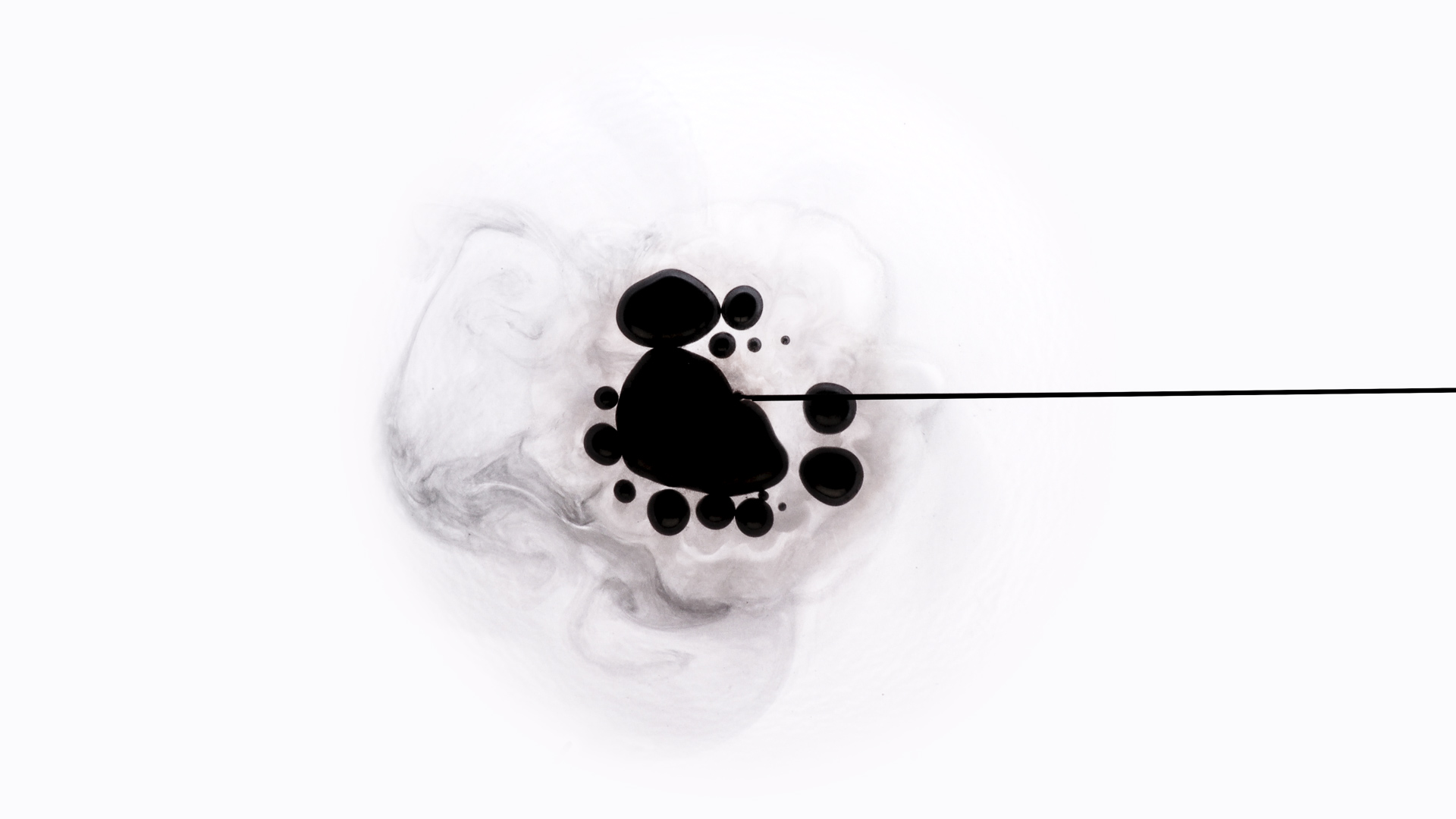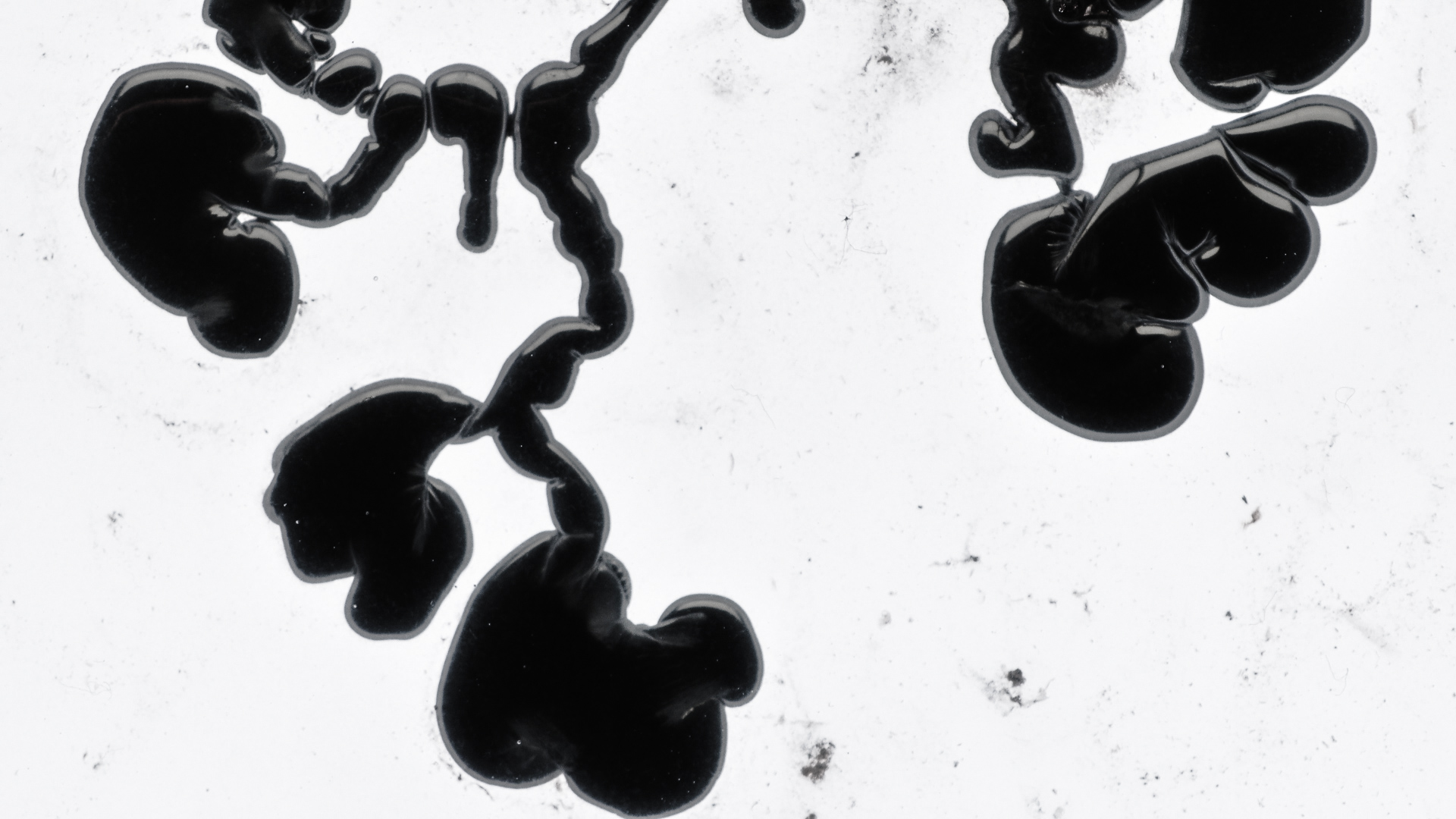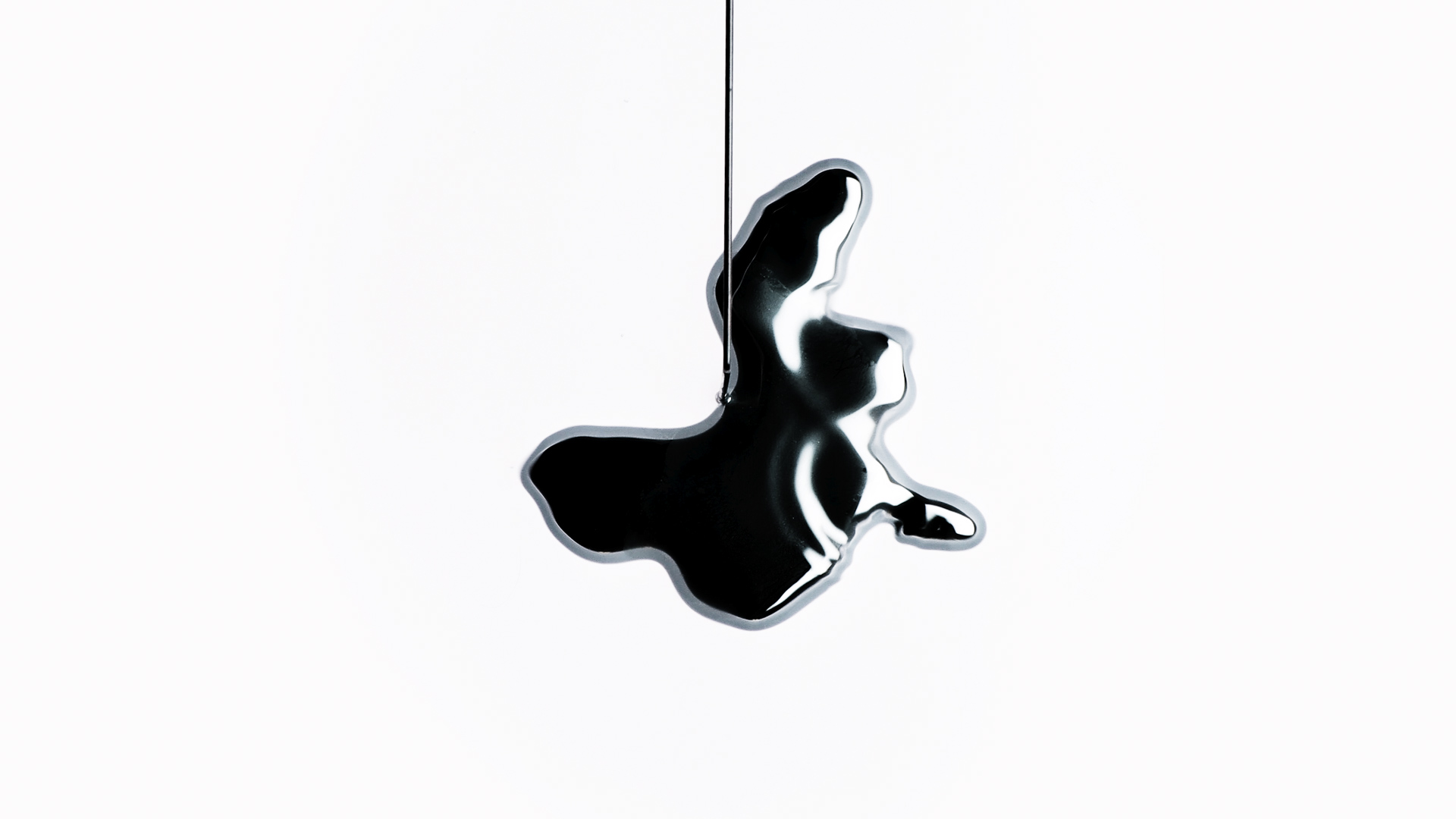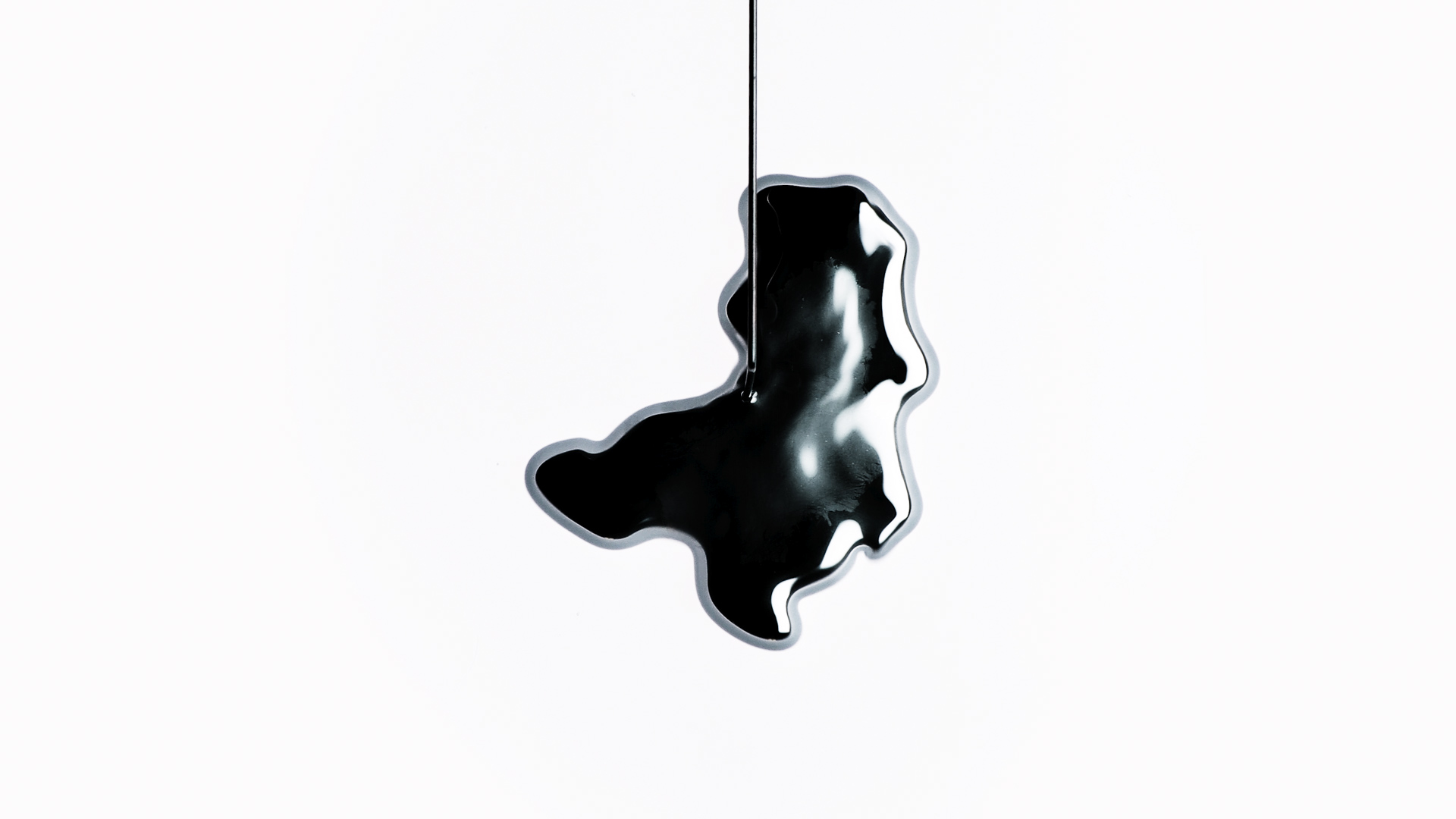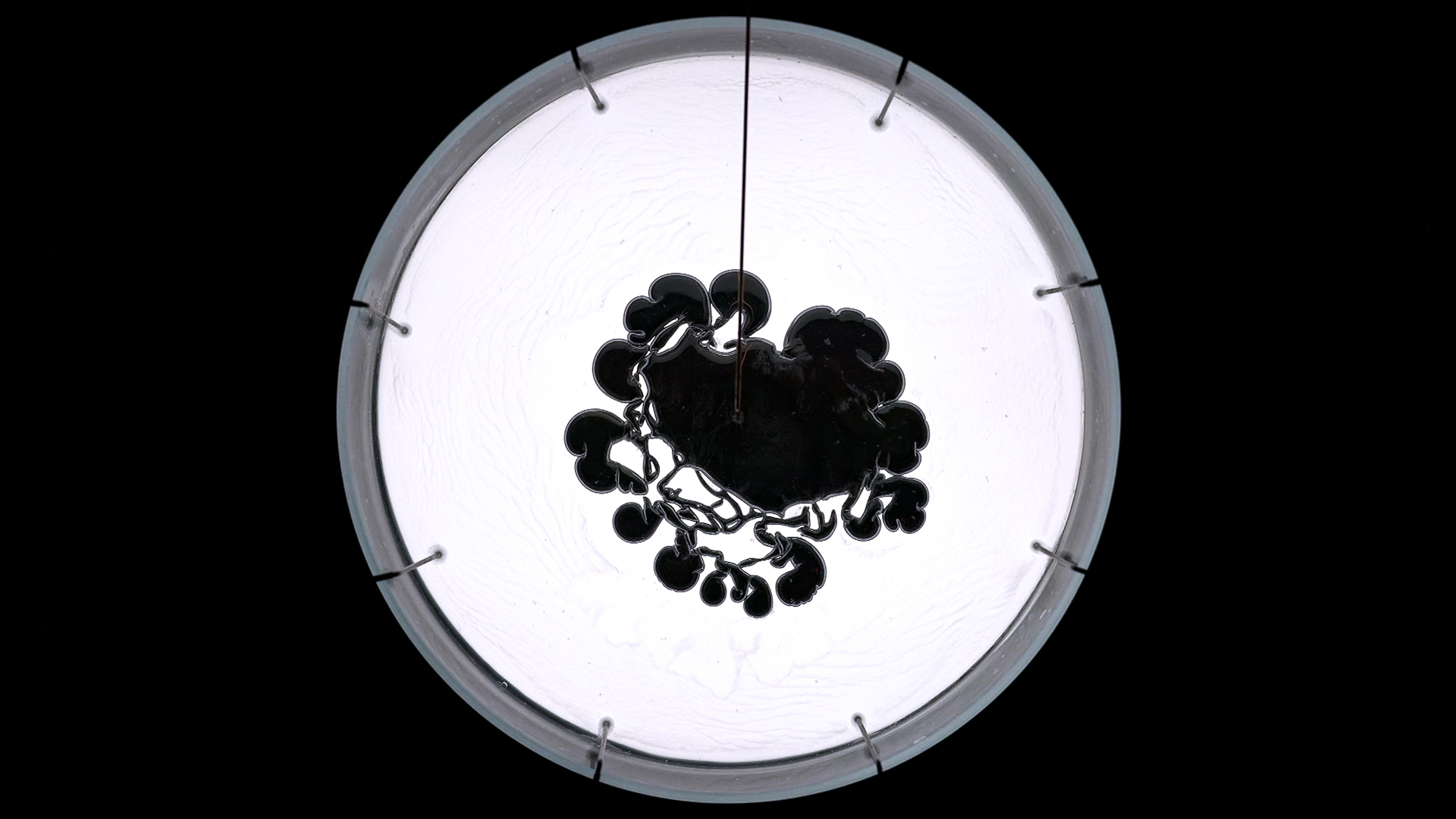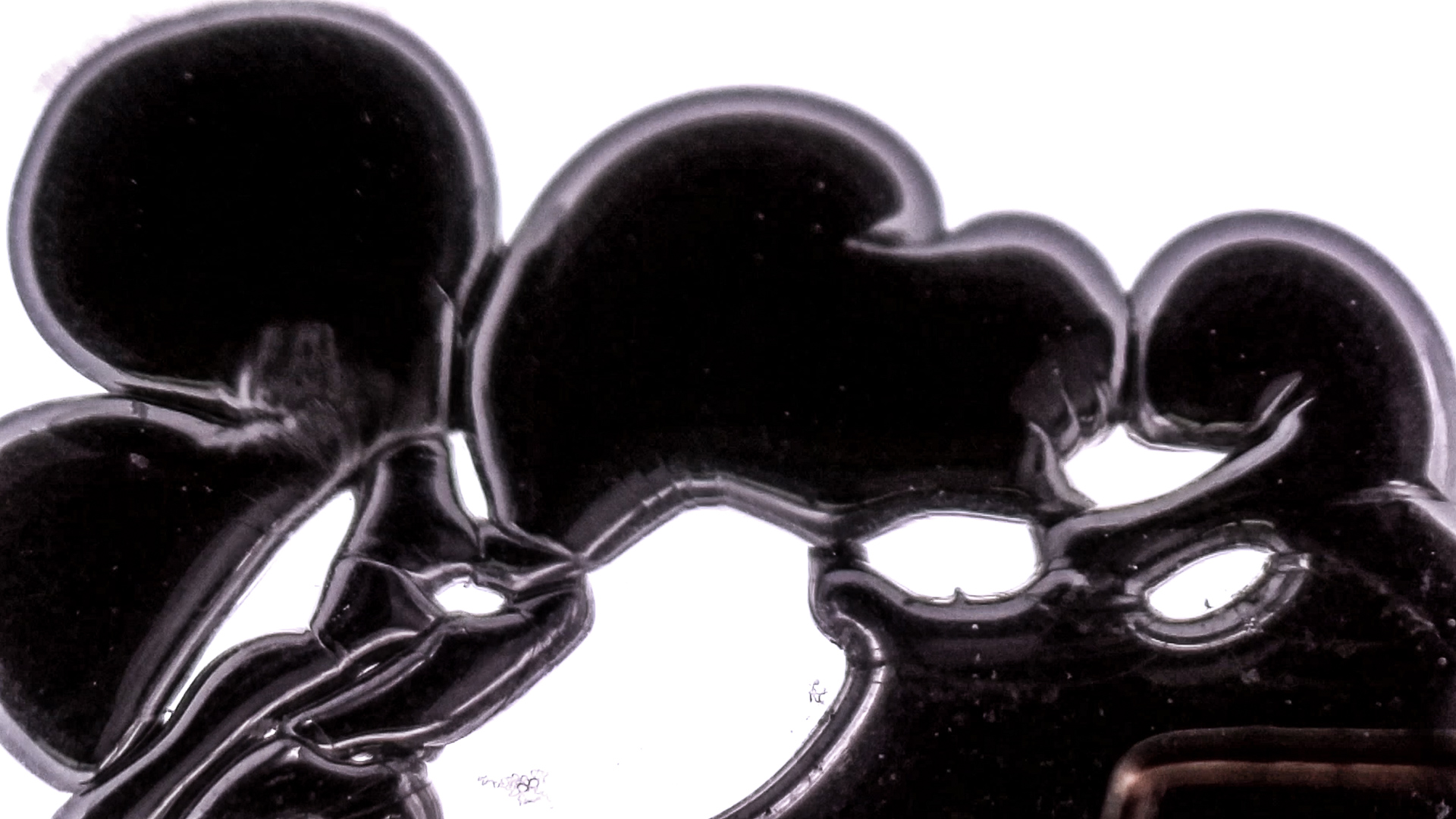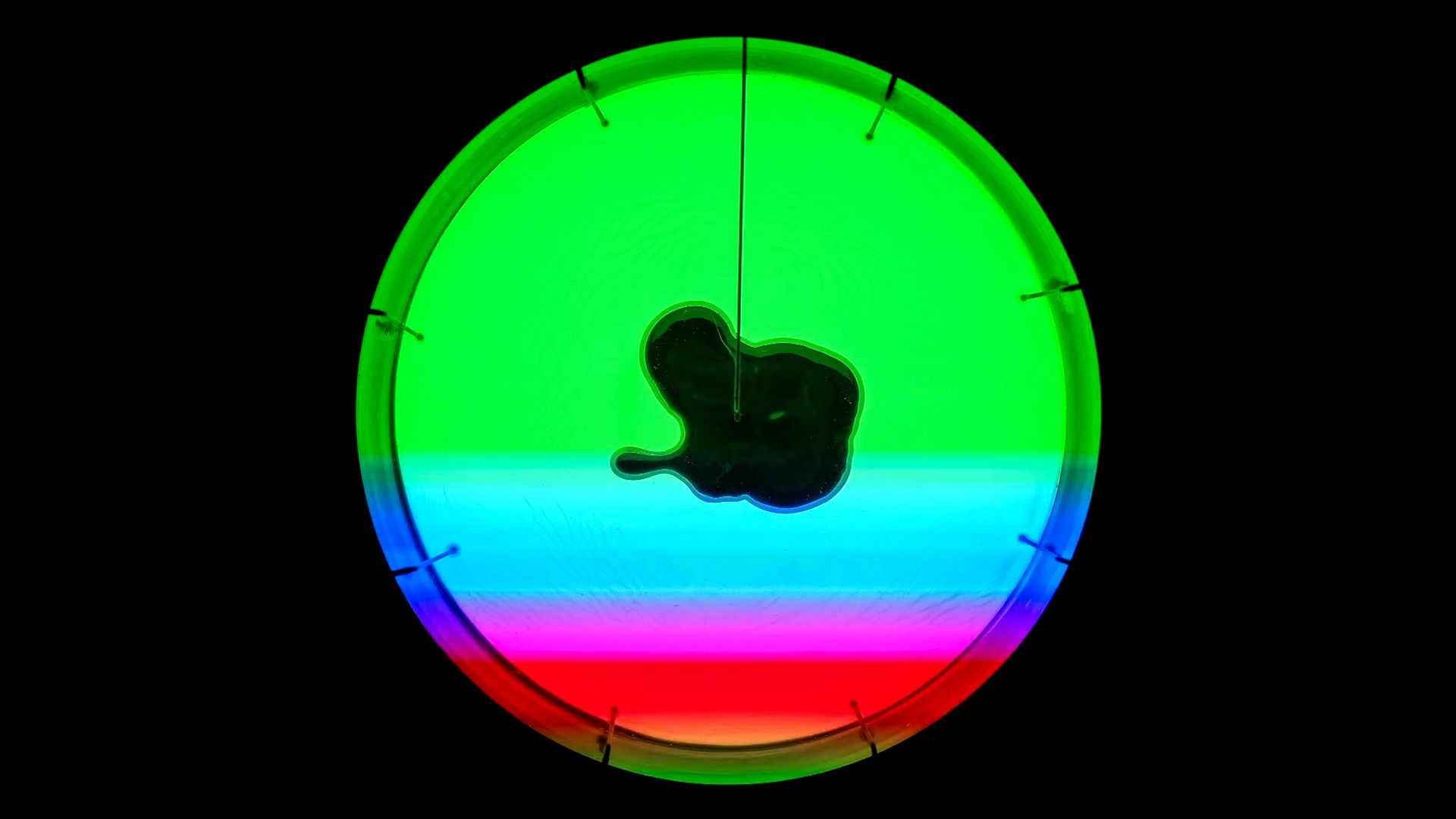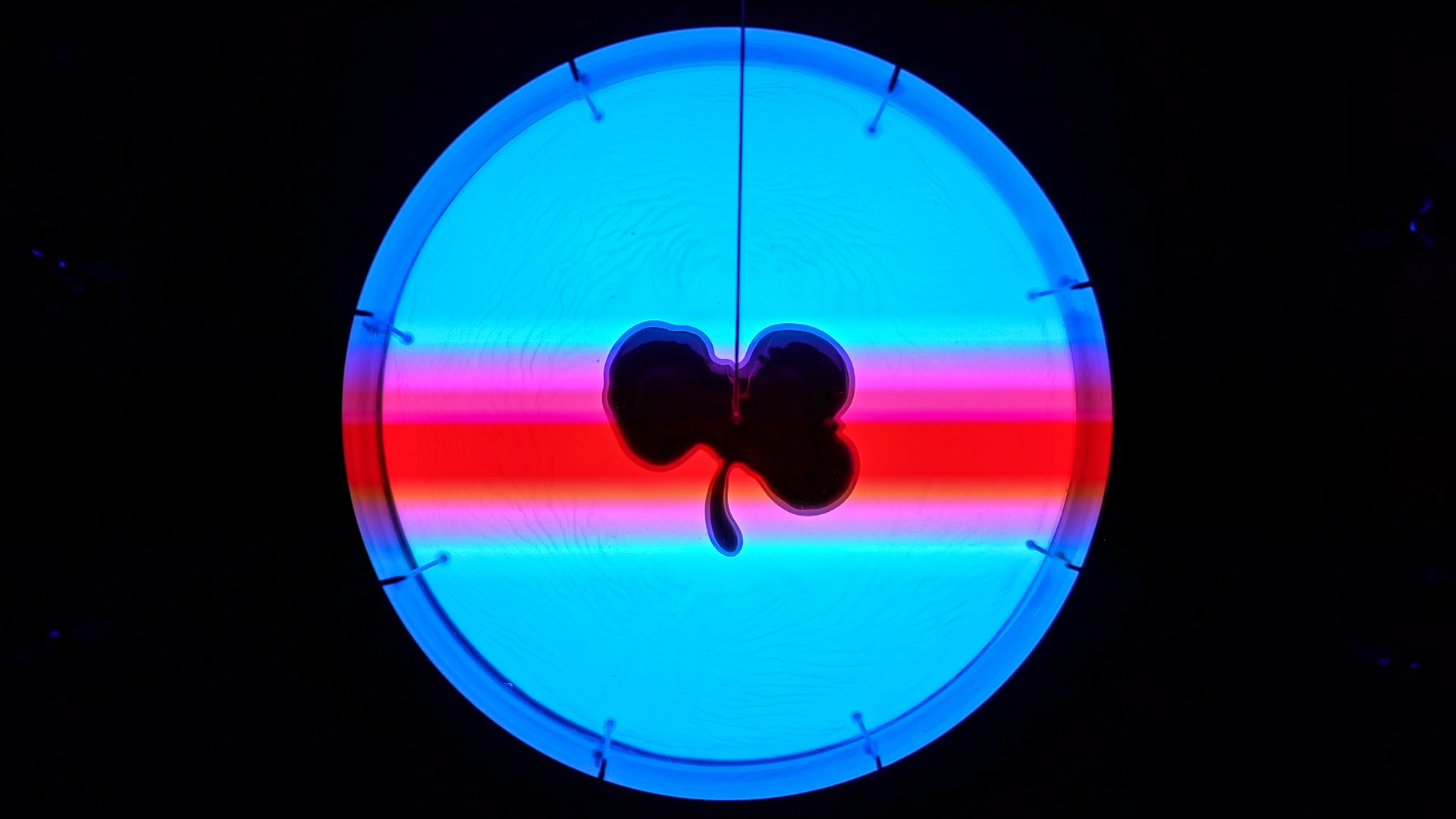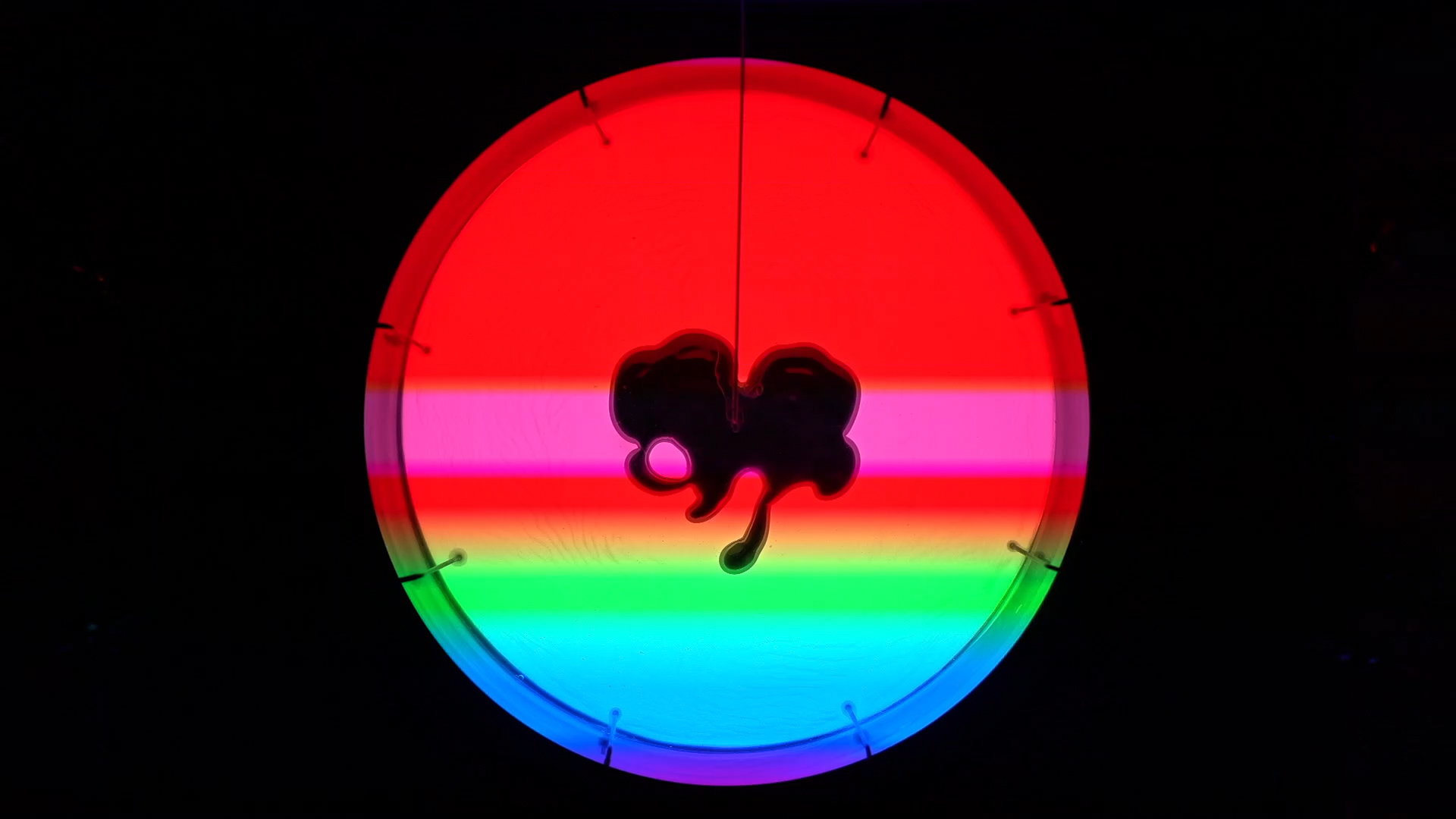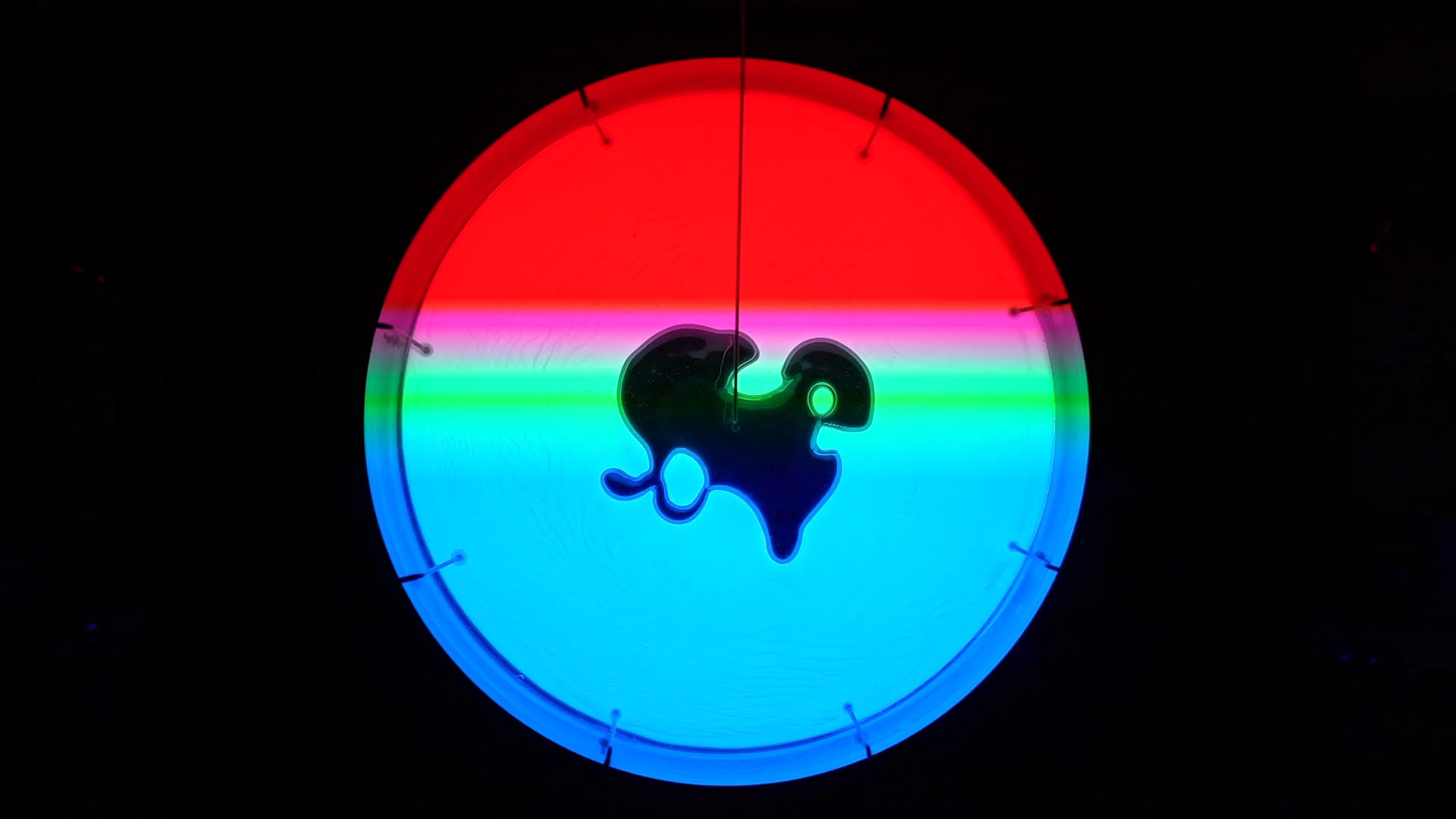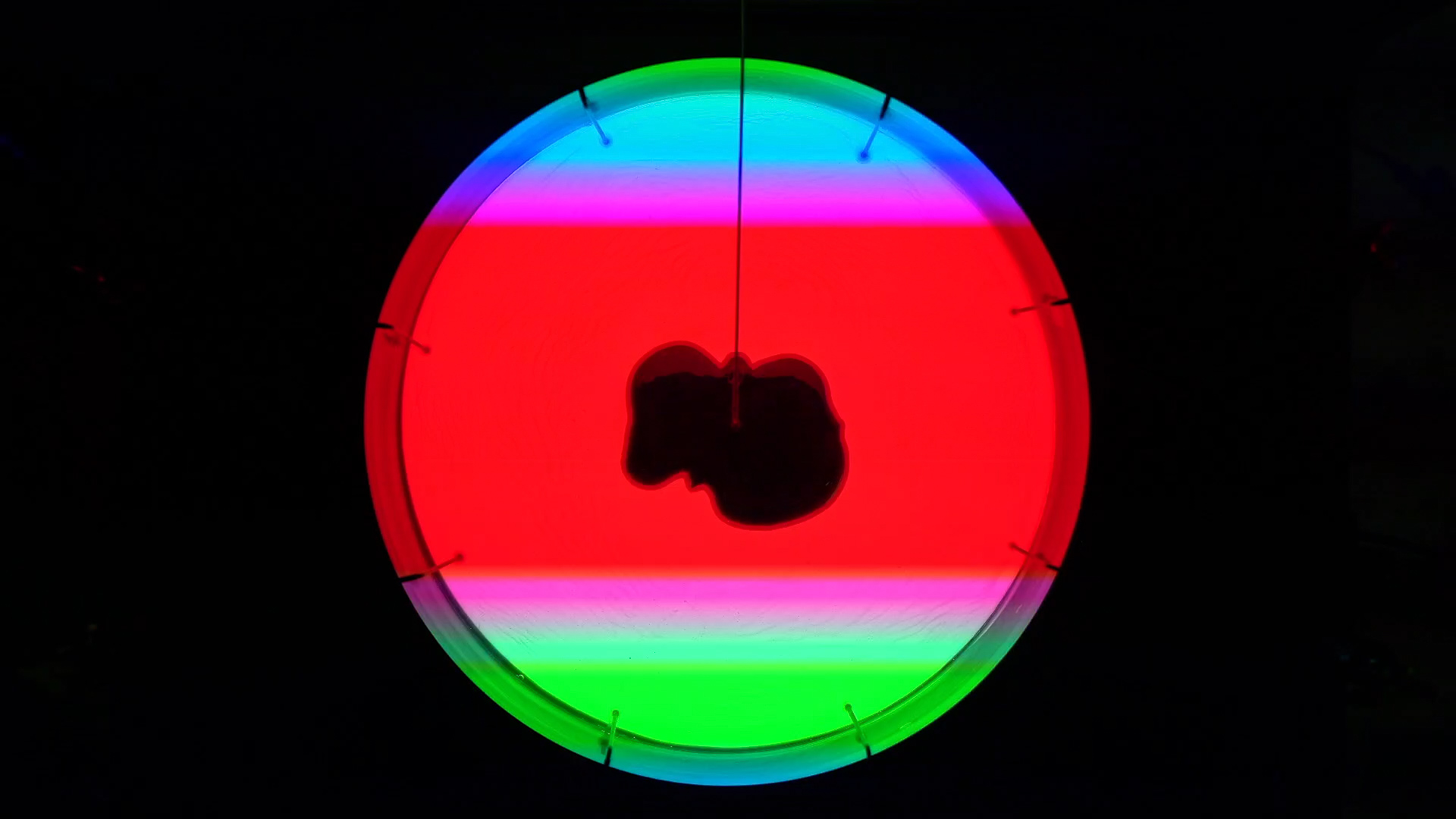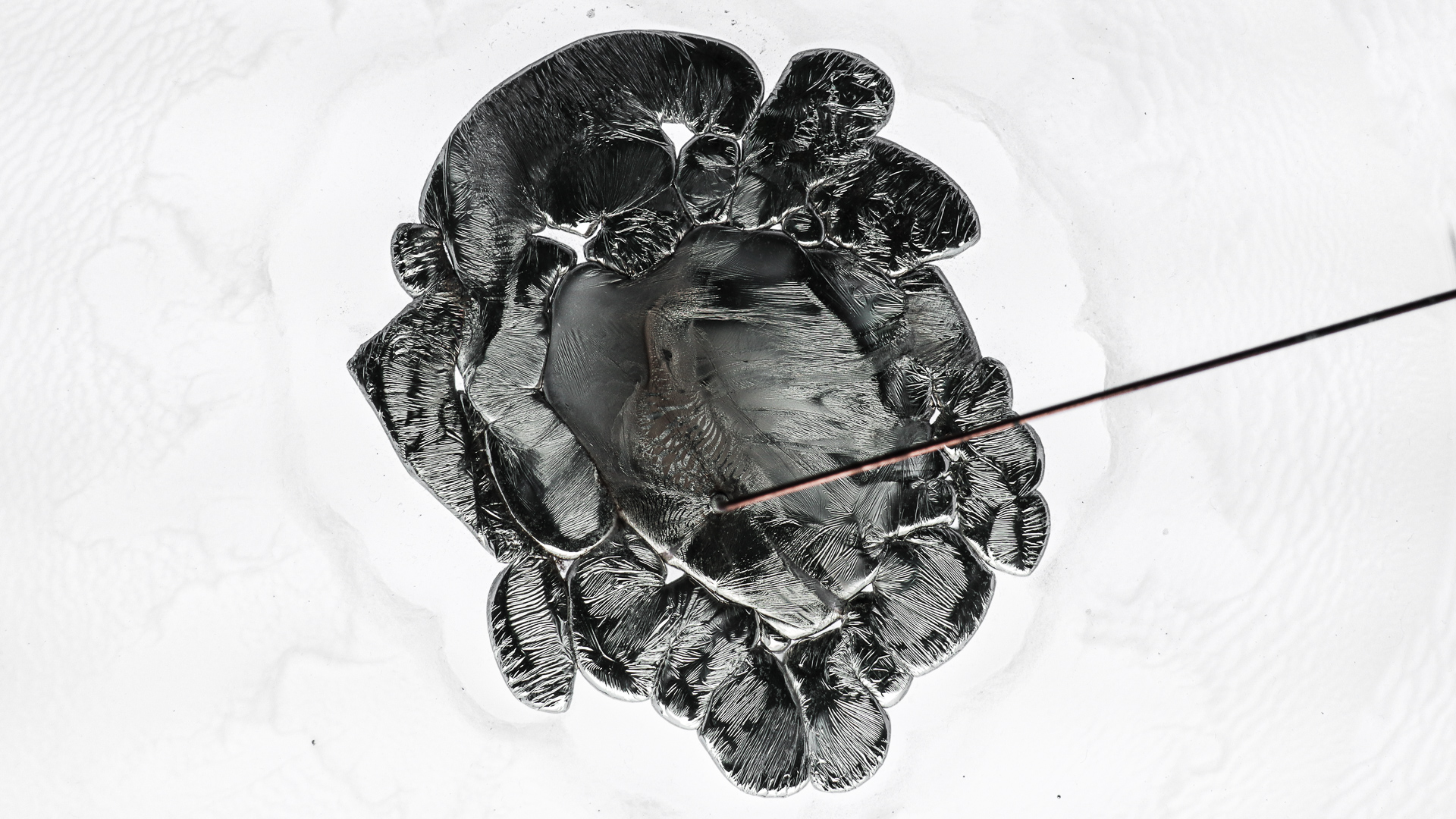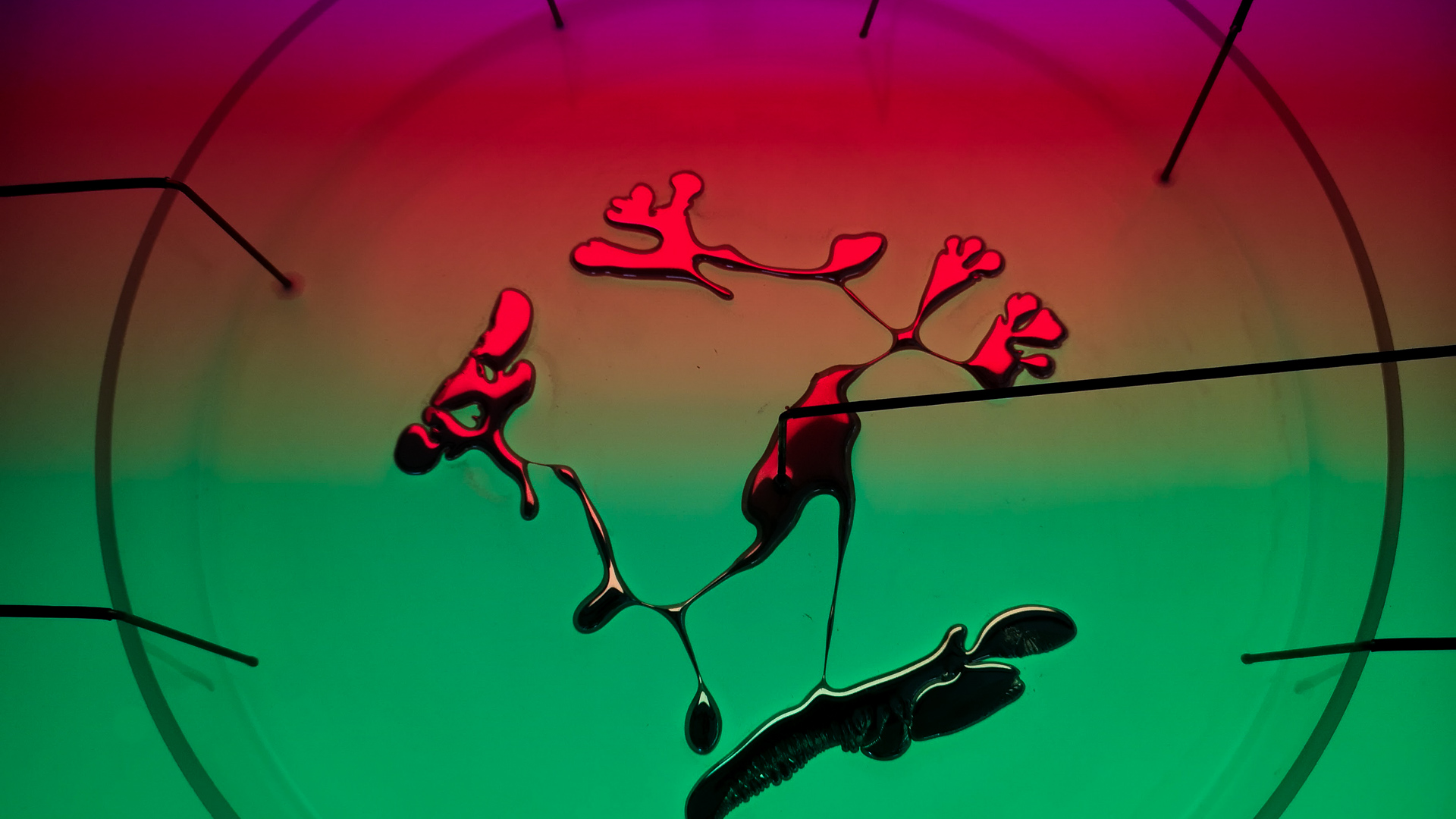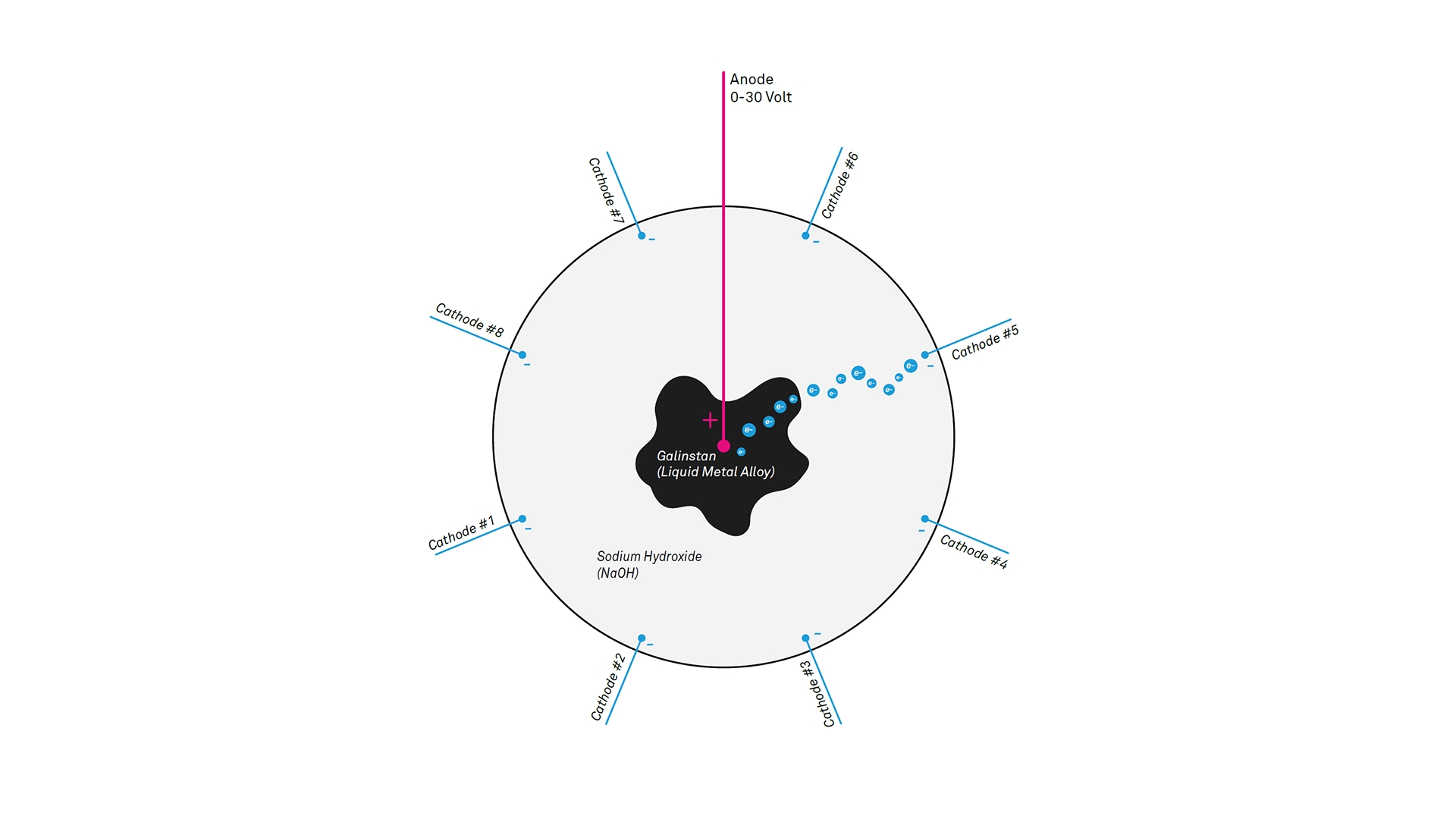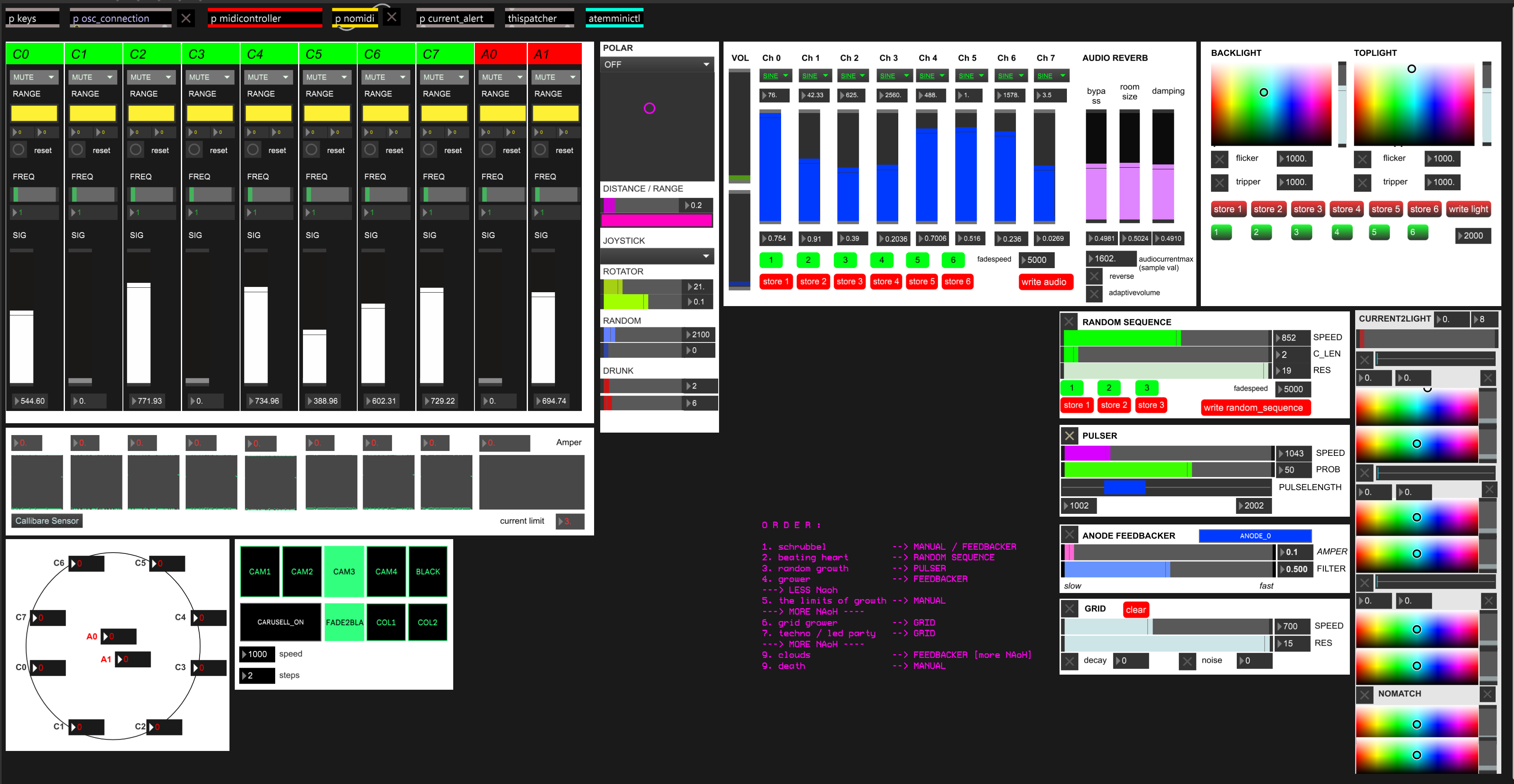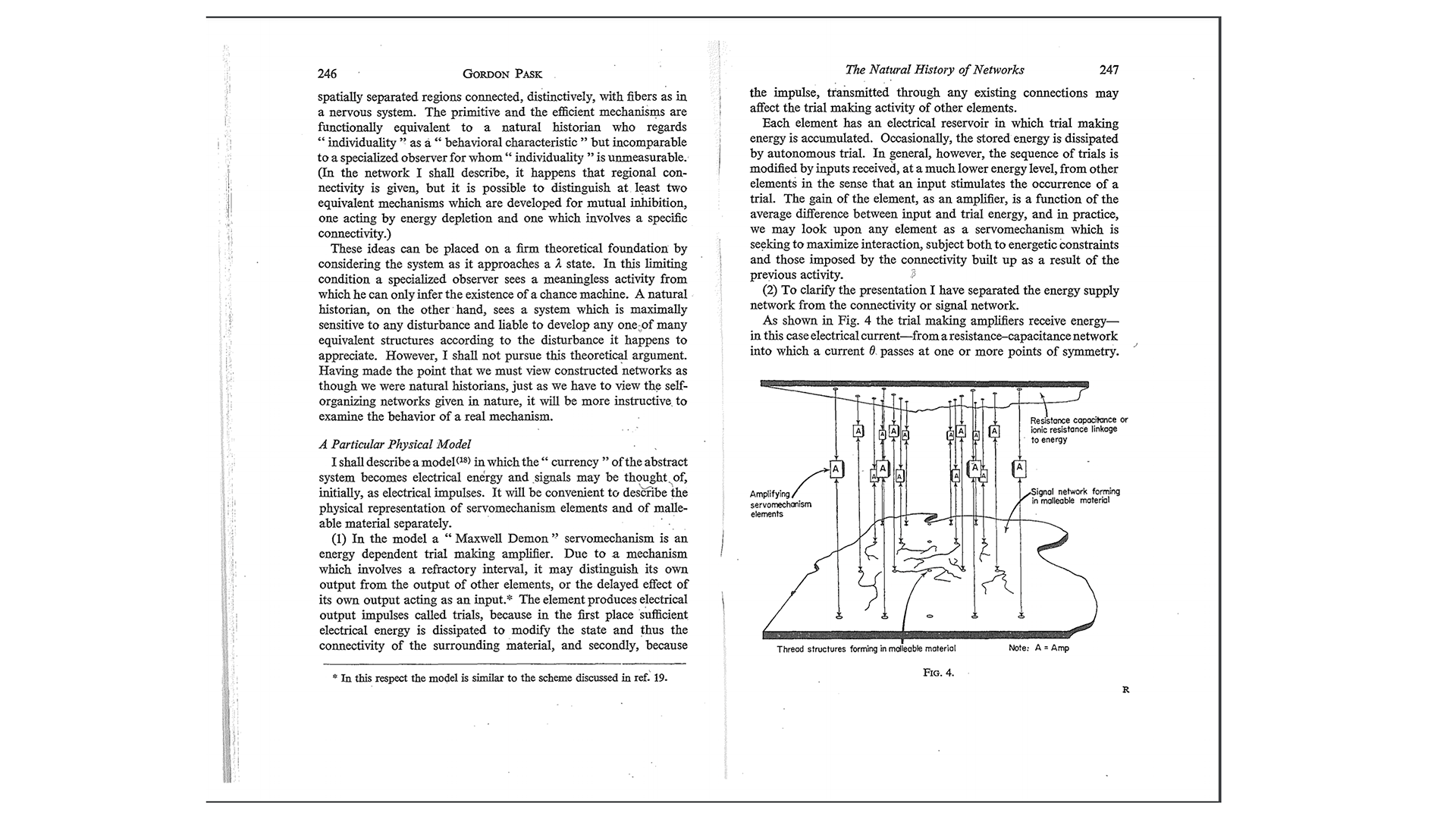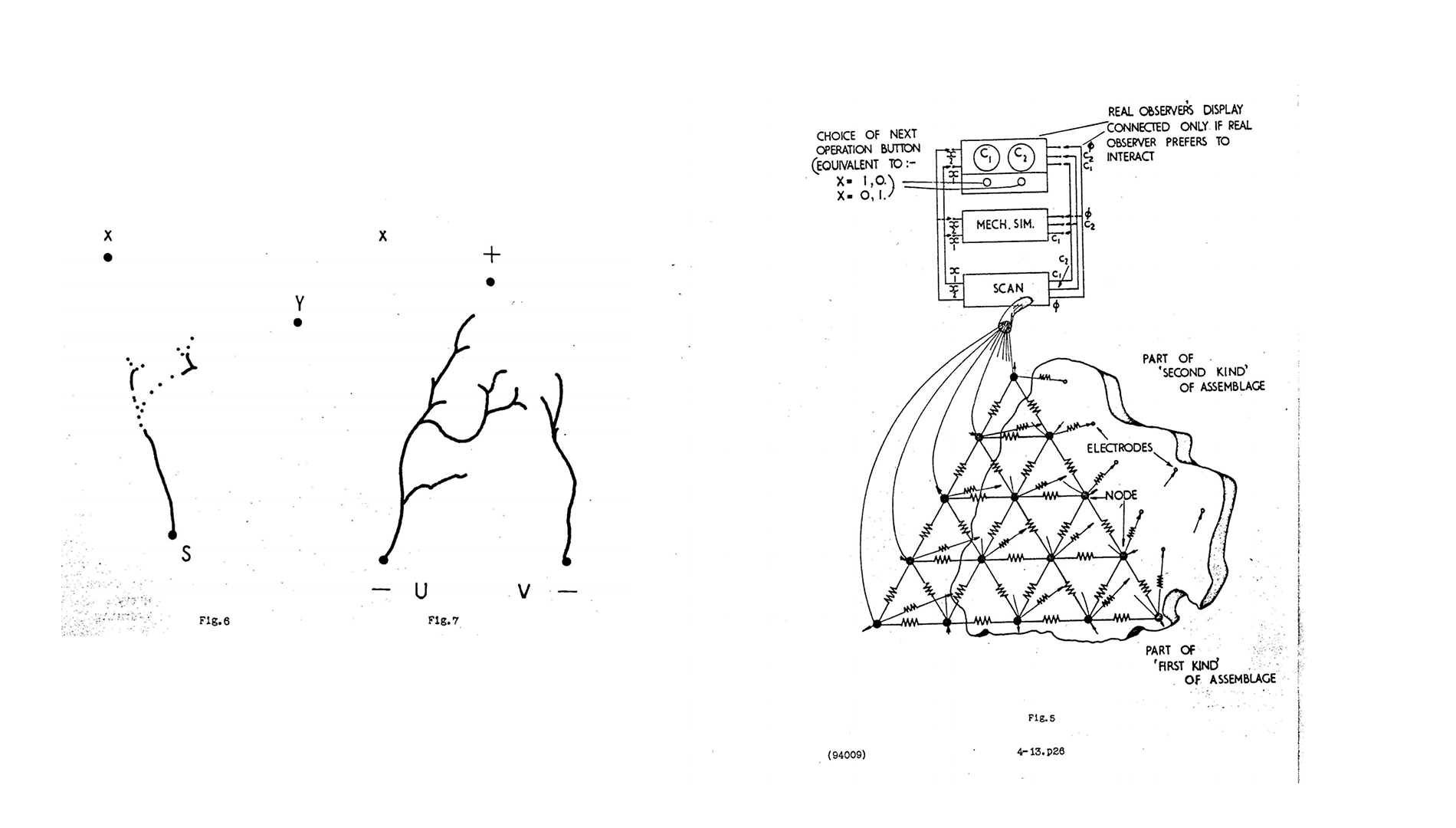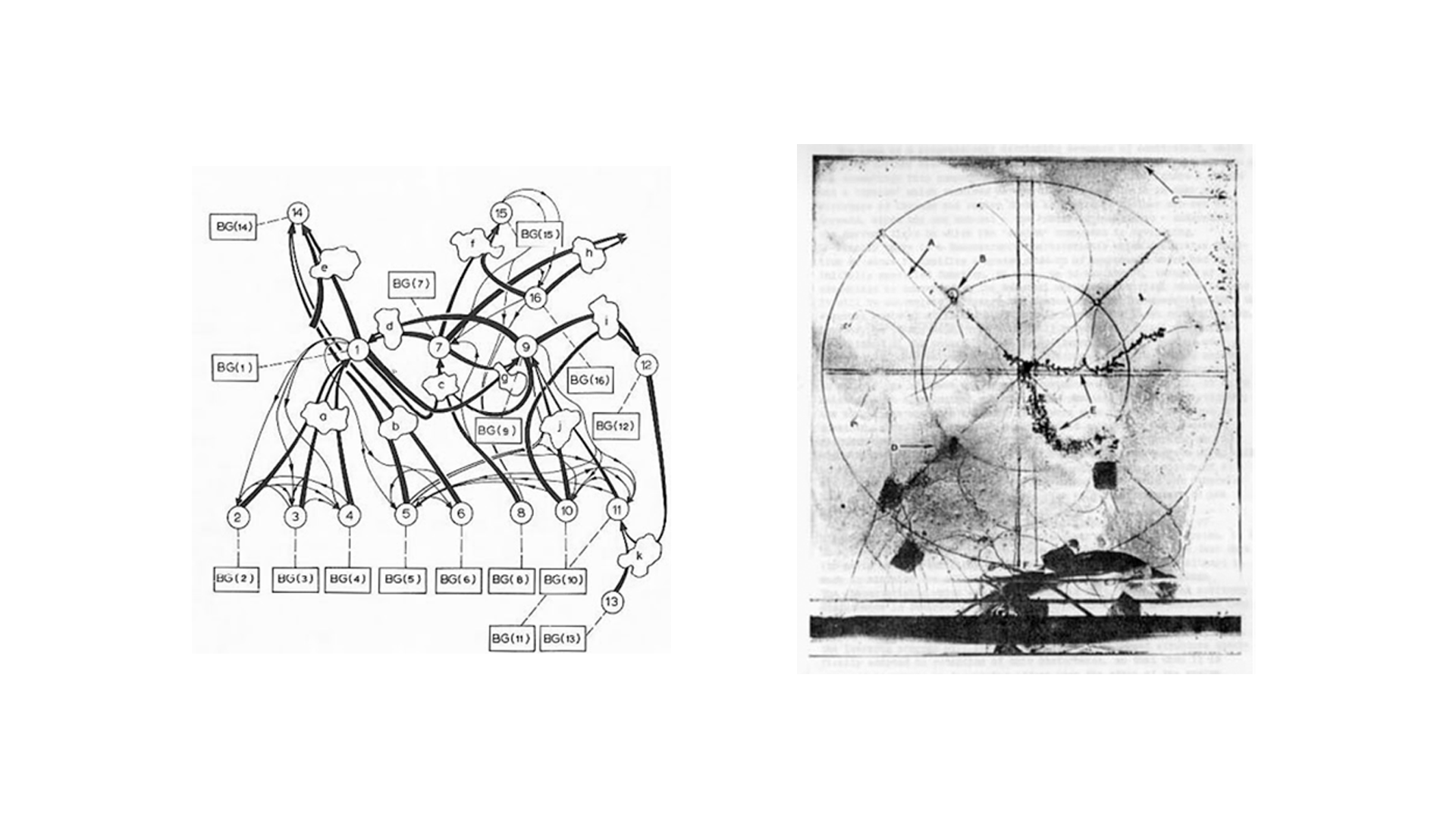Every object, naturally, emerges like Aphrodite from a flux of elements. … Born from this and, as soon as it is born, complex, twined, twisting its long thick hair, it begins to transmit, in floods and in all directions, a star of flow: its wear and its time. It radiates various waves: heat, odors, sounds, simulacra, subtle atoms. In the same way or inversely, it receives the flow emitted around it, from the vicinity and the edges of the open universe alike. (Lucretius, De rerum natura paraphrased in Michel Serres,The Birth of Physics, 1980)
A Natural History of Networks/Softmachine is an audiovisual performance/electrochemical image and sound synthesizer that probes an alternative computational and technological material regime, informed by Gordon Pask’s experiments on electrochemical learning mechanisms and current research on biomimicry, programmable matter, and spatiotemporally controlled liquid metal actuators. At its core, a custom-built electrochemical experimental apparatus (Softmachine) creates a dynamic fluidic microcosm that performs a continuous becoming of form, structure, and material narrations. The performance aims to provoke new imaginaries of the machinic, the artificial, and matter. A radical technology that bridges traditionally discrete machine thinking and soft/fluid materials that enable self-organizing behavior through their specific material agencies.
The performer is manipulating and modulating Galinstan, a liquid metal alloy composed of gallium, indium, and tin immersed in a solution of sodium hydroxide (NaOH). This inorganic “wetware” is stimulated by applying alternating electrical pulses through a set of electrodes. The evolving plexus of liquid metal creates distinctive electrical milieus (resistances/currents) in the chemical system. By sensing, analyzing, and acting on changes in the shape-shifting fluid, a uncontrolable process is triggered in which the network reacts to its input in a closed feedback loop. Models and methods of self-organization are introduced into the system to enable homeostasis to occur. The performance itself is a narration improvised through various states and behaviors of the system.
Softmachine is an analog/digital hybrid to speculate about a heterogeneous technological culture. The neo-alchemistic material performance is captured by multiple cameras and composed and displayed in real-time on a projection screen. The visuals are accompanied by a sonic layer, the direct translation of the electrochemical processes taking place in the fluid, and a mélange of drifting frequencies, pulses, patterns, and noise -– an electrochemical synthesizer.
The process can be described as a dissipative structure, a term introduced by the physical chemist Ilya Prigogine. It is a negative entropy flow that exists in an open system far away from its equilibrium state. The evolving fractals and structures result from energy exchanges between the inside and the outside of the system. A dissipative structure is characterized by the spontaneous appearance of breaks in the symmetry (anisotropy) and the formation of complex, sometimes chaotic structures, where interacting particles exhibit long-range correlations. These kinds of systems appear on different scales, from hurricanes to chemical reactions and living organisms.
The apparatus is based on current scientific research on liquid metal actuators, programmable matter, and soft robotics that enable flexible actuation, intelligent sensibility, and biomimetic functionality. A Natural History of Networks refers to the idiosyncratic research of the British cybernetician Gordon Pask, whose work deals with a theory of conversation and electrochemical learning mechanism (e.g. in Pask’s Physical Analogues to the Growth of a Concept, and in The Natural History of Networks).
Gordon Pask’s organic computer
Gordon Pask’s “organic computer” (1960) can be read as a counter-design to Alan Turing’s model of a general-purpose computer (Turing machine). It is an extremely open-ended system for modeling a “thinking” machine—a machine that uses an electrochemical growth process to grow formations of conceptual categories (such as neural networks) in an aqueous solution of metallic salts. Pask uses electrodes to introduce currents into the system to grow iron threads between the electrodes. Based on emergent behavior, the system starts growing threads and electrical connections depending on the currents/signals introduced in the chemical solution. The emerging structures (assemblage) represent computation capabilities by “responding” to their inputs with the resistance structure that is grown. The system evolves its own sensors “to choose, independent of the designer, those aspects of its external environment to which it would react.” Even though the device never reached the application stage, it acts as a thought-provokingly obscure machine.
“The contention is that if an observer wishes to use any self-organizing potentialities the network may have, then he must look at the network as though he were a natural historian. (…) We can, of course, look at a system in any way we choose, regardless of whether or not it is self-organizing. Thus, we can look at a man from the anatomical point of view and see a creature with two legs, bounded by its skin. Again, we might examine man like the sociologists and see a badly defined game player. The contention is that in order to use the self-organizing character of a man we must become natural historians, which means, for the human system, that we must talk to it. In conversation, the system appears to be bounded at one moment by the anatomist’s skin, and at the next moment, by its region of influence upon other men in society. Typically a natural historian must change his viewpoint to suit a changeful system.” — The Natural History of Networks, Gordon Pask, 1960
video recordings of full performances
2022-02-13 New Tretjakow Galerie Moscow RU
2021-11-27 Shiny Toys Festival, Ringlokschuppen, Mülheim an der Ruhr DE
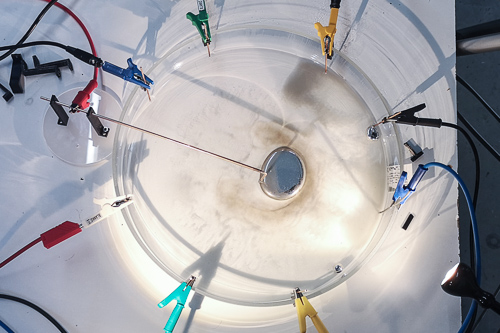
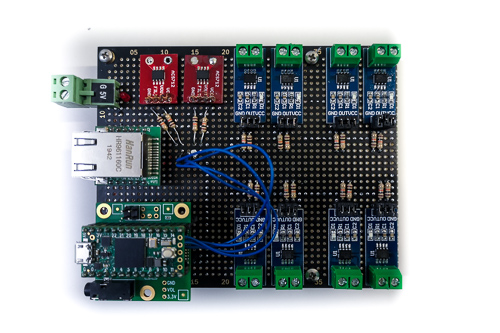
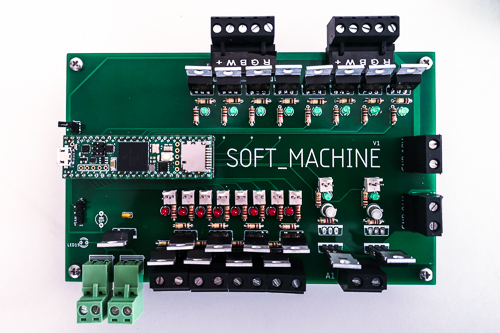
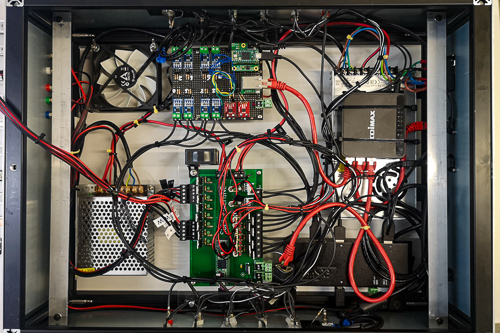
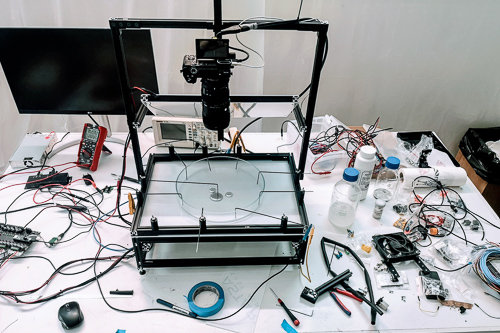
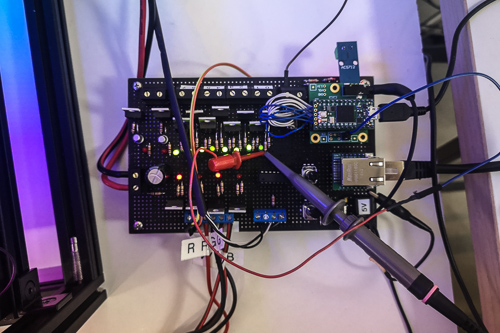
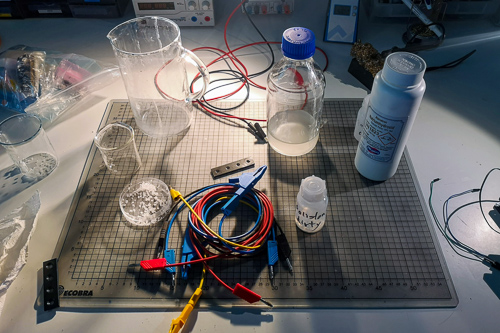
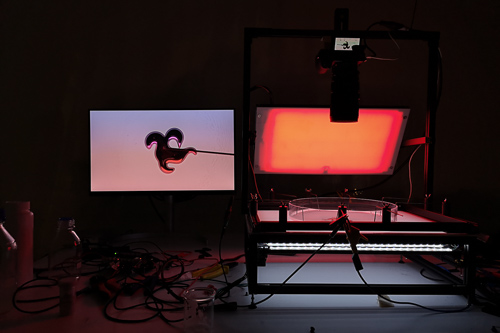
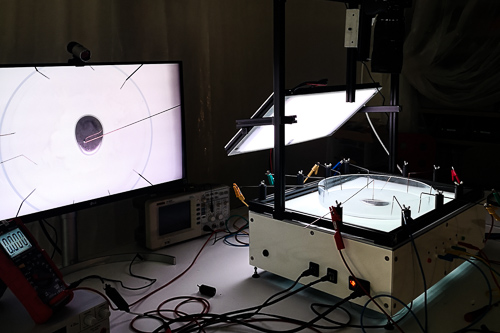
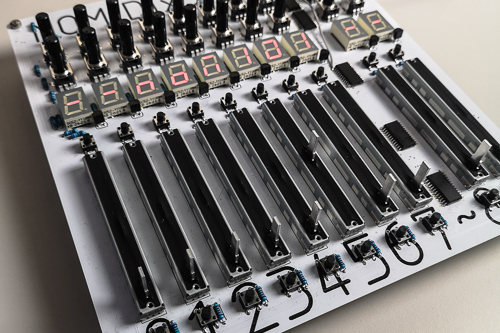
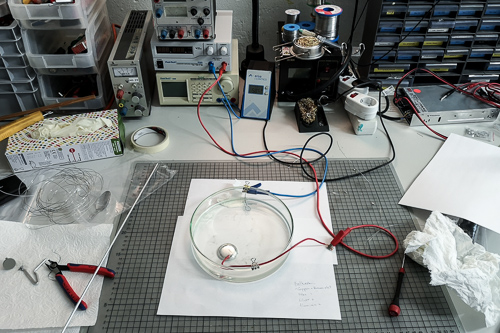
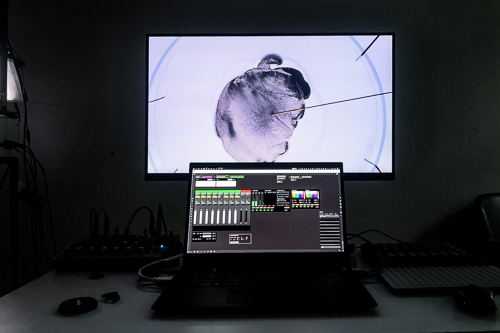
Materials:
Galinstan, sodium hydroxide, water, petri dish, custom electronics, microcontroller, aluminum framework, custom backlight, custom led lights, microcontroller, cables, cameras, projector
Credits:
Concept, development, production and performance: Ralf Baecker
Assistance and videography: Julian Hespenheide
Special thanks to STATE Studio Berlin for hosting and streaming.
Thanks to Ada Weller for the construction assistance
References/Resources:
+ Gordon Pask: The Natural History of Networks (1960)
reprinted in Self-Organizing Systems, London: Pergamon Press, 1960
+ Gordon Pask: Physical Analogues to the Growth of a Concept (1959)
reprinted in Mechanisation of Thought Processes, London: HMSO, 1959
+ Michelle Serres: The Birth of Physics, Rowman & Littlefield Publishers, 1980
+ Ilya Prigogine & Isabelle Stengerss: Order Out of Chaos- Man’s New Dialogue with Nature, London, Heinemann, 1984
+ Sen Chen, Lei Wang, Quinglei Zhang, Jing Liu: Liquid metal fractals induced by synergistic oxidation, Science Bulletin Volume 63, Issue 22, 30 November 2018
+ Faegheh Hoshyargar, Husnaa Khan, Kourosh Kalantar-zadeh and Anthony P. O'Mullane: Generation of catalytically active materials from a liquid metal precursor,Chemical Communications, 2015, 51
+ Jie Zhang, Lei Sheng and Jing Liua: Synthetically chemical-electrical mechanism for controlling large scale reversible deformation of liquid metal objects, Sci Rep. 2014; 4: 7116. Published online 2014 Nov 19.
+ Leily Majidi, Dmitry Gritsenko and Jie Xu: (Mechanical and Industrial Engineering, University of Illinois at Chicago, Chicago, IL, United States) Gallium-Based Room-Temperature Liquid Metals: Actuation and Manipulation of Droplets and Flows, Mechanical Engineering, 30 August 2017
Exhibitions/Performances:
A Natural History of Networks at Hidden Layers Conference (upcoming)
2024-06-13
Köln Internatinal School of Design, Cologne DE
A Natural History of Networks @ Expanded Program (upcomming)
2024-05-04
Kurzfilmtage Oberhausen, Oberhausen DE
A Natural History of Networks/Softmachine (solo)
2023-09-30 - 2023-09-30
Meinblau Projektraum, Berlin DE
Flatpack Festival
2023-05-19
Flatpack Festival, Birmingham UK
Maintenant Festival
2022-10-08
Les Champs Libres, Rennes FR
Vector Hack Festival
2022-10-01
Vector Hack Festival, Zagreb HR
Beijing Art and Technology Biennale
2022-09-23 - 2022-01-31
798 CUBE Art Center, Beijing CN
Anachronism
2022-04-05
Schwankhalle, Bremen DE
Electrons Libres
2022-02-25
Stereolux, Nantes DE
Symposium New Elements
2022-02-12
Laboratoria / New Tretjakow Galerie, Moscow RU
Gaia: Gene, algorithm, intelligent design, automata _A mirage self, The Other Realm
2022-02-12 - 2022-04-24
MOCA (Museum of Contemporary Art), Taipei TW
New Elements
2021-11-08 - 2022-02-27
Laboratoria / New Tretjakow Galerie, Moscow RU
Shiny Toys Festival
2021-11-27
Ringlokschuppen Ruhr, Mülheim an der Ruhr DE
Future Media Art Festival
2021-10-09 - 2021-11-23
Taiwan Contemporary Culture Lab (C-LAB), Taipei TW
A Natural History of Networks/Softmachine
2021-01-29
STATE Studio, Berlin DE
